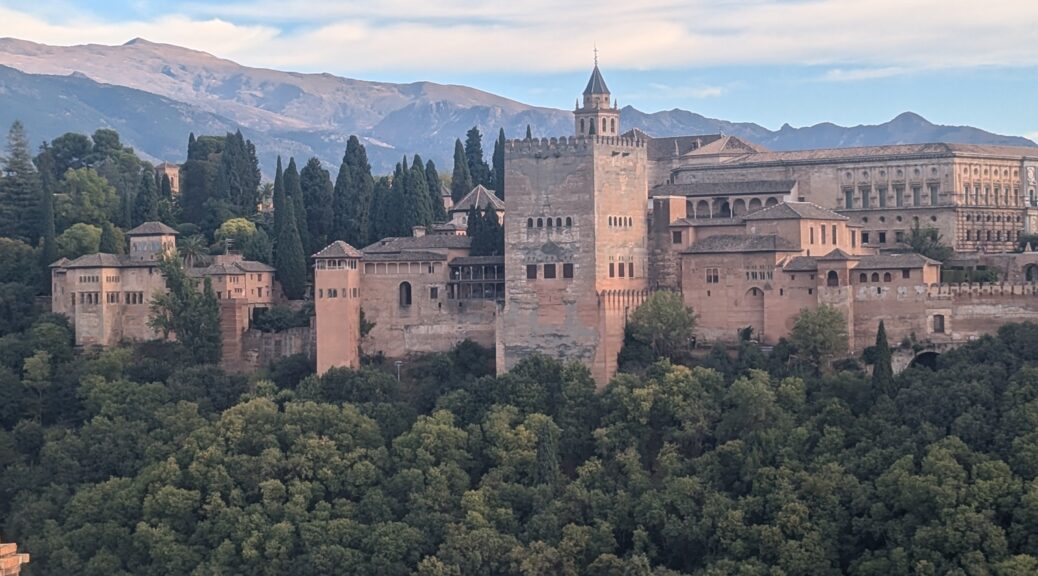
Andalusia: Seville, Cadiz, Malaga, Granada, Cordoba
I finally got my D7, Portugal Residency Card, so I could start planning trips to other European countries without worrying about being deported for violating EU immigration rules.
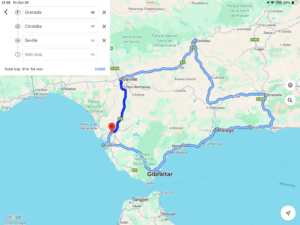 Kelly was interested in visiting Spain with me, so I planned several different itineraries for Andalusia. I had one that was 14-15 days but we cut a few sites. We were both pleased with our final schedule though, Seville, Cadiz, Gibraltar, Malaga, Granada, Cordoba, then back to Seville to drop off Kelly at the airport. Kelly had round-trip tickets to Seville, and I drove over from Lagos, Portugal to pick her up and start our road trip.
Kelly was interested in visiting Spain with me, so I planned several different itineraries for Andalusia. I had one that was 14-15 days but we cut a few sites. We were both pleased with our final schedule though, Seville, Cadiz, Gibraltar, Malaga, Granada, Cordoba, then back to Seville to drop off Kelly at the airport. Kelly had round-trip tickets to Seville, and I drove over from Lagos, Portugal to pick her up and start our road trip.
Seville
After picking up Kelly from the airport, I drove to the parking area I had picked out in advance. After 3 years on the road, and the past year of driving in Portugal and narrow ‘old town’ roads in the Algarve, I try to minimize my road stress. So I found outside of city center parking in all locations.
We took a Bolt to our hotel, Suites Hom Seville and dropped off our bags. It was a great location in old town, close to the Cathedral and Alcazar. The hotel was excellent, nice couch, large bathroom, and a kitchen area.

We walked around old town, the cathedral and plazas for a few hours and stopped for some sangria before our walking tour. We had booked the Historical Tour with Free Walking Tours, for the first afternoon. We met in Plaza Nuevo. We had a group of about 12 and a great guide. We walked through Plaza de San Francisco, to the Cathedral, stopping to see the monuments in Plaza del Triunfo and the Patio de Banderas.
We visited the Barrio de Santa Cruz, the old Jewish quarter, learning about the history of that neighborhood. We ended the tour in the amazing and huge Plaza de Espana. So large, it is hard to show in pictures. Wandering back to our hotel, through the Parque de Maria Luisa, we found Milonguitas for dinner. Kelly wanted a burger but I had some excellent tapas, including eggplant and goat cheese.

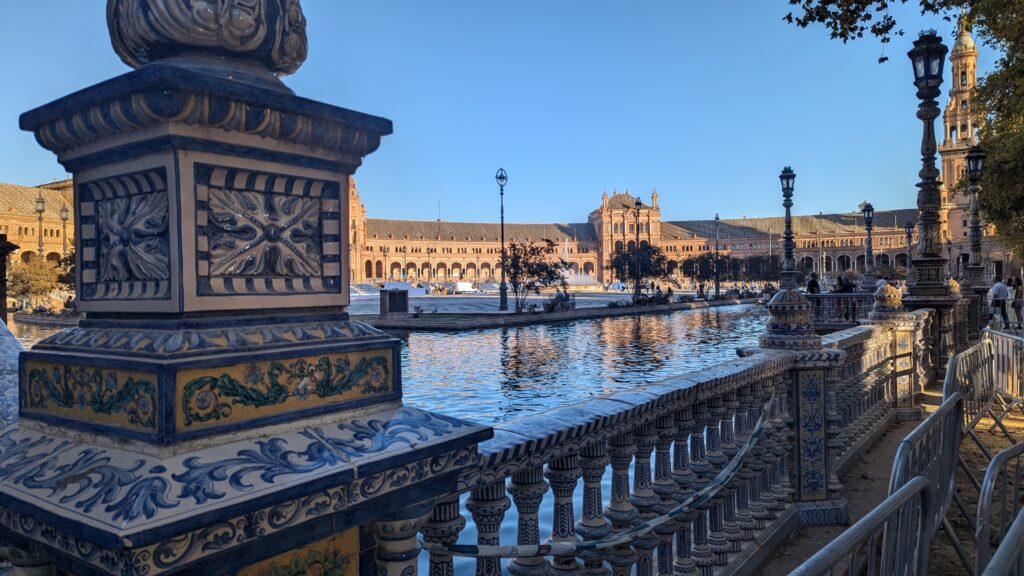
We had purchased the Real Alcazar tickets, including the Royal Apartments, in advance for our second day. We paid 21€. I am glad we read that information online as several people on the walking tour said they tried to get tickets while in town and everything was sold out.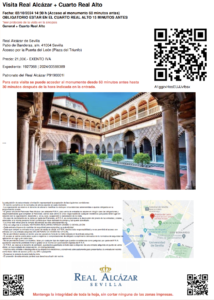
We got in line and went right to the Royal Apartments at our specific time. There are only a few allowed in the Royal Apartments at any time. We had to leave all belongings in a locker and were guided by a guard. We had headsets that explained each room and the guard would motion us on to the next location. They are amazing rooms and I recommend seeing them.
After leaving the Royal Apartments, and grabbing our backpacks, we spent the next several hours visiting the rest of the large complex. Incredibly beautiful with gorgeous gardens.
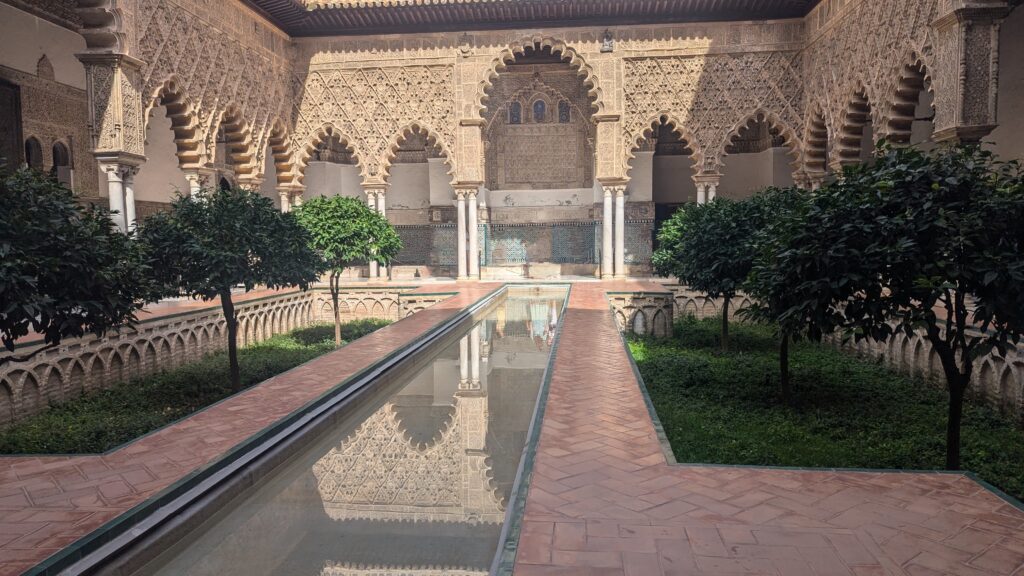

We had also looked at buying Seville Cathedral tickets before our trip. The speciality tours, the stained glass, rooftop, and guided tours, were all booked a month before, but there were 100s of tickets both days for just entry. There were. We didn’t purchase in advance because we weren’t sure of the time we’d be free (all tickets were timed entry). Unfortunately, when attempting to buy tickets while at the hotel, it was completely sold out both days. We tried going by first thing in the morning and asking about availability but the line, before opening, wound around the building.
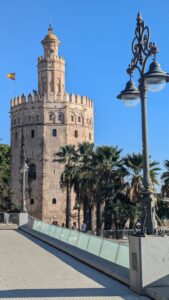
After a good breakfast at Genova, close to our hotel, we had a fantastic morning exploring more of the city. We went to the Torre del Oro, or Golden Tower, right on the Rio Guadalquivir. We bought river cruise tickets for later that afternoon after our Alcazar tour. It included another free walking tour. It was going to visit different parts of the city than our previous tour, and it was the right timing, so we went to starting point. However, it was a very large group, the guide was extremely hard to both hear and understand so we left after about 30 minutes.
We explored more of Barrio de Santa Cruz and visited the Iglesia de Santa Maria la Blanca and the museum upstairs. What a beautiful church, only 2€.
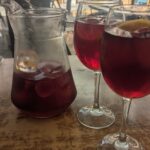 We had a great pitcher of sangria for lunch before heading to the Alcazar. It’s vacation!
We had a great pitcher of sangria for lunch before heading to the Alcazar. It’s vacation!
After leaving the Alcazar, we went back to the river for our 1800 boat trip. It sails up the river, past the Puente de Triana and the Puente del Cachorro before turning and sailing past the Parque de María Luisa. We had walked through this beautiful park on the way back from Plaza Espana the previous night. We turned around by the Puente de las Delicias and returned to the Torre de Oro. It had a pre-recorded audio guide. I enjoyed it and it was nice to just sit for an hour.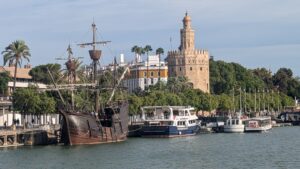
We had dinner at Uno de Delicias with some great tapas, including a Spanish Tortilla. It was so good and unique, I was disappointed by the 2 others we had later in the week.
We returned to our hotel through the Jewish Quarter enjoying the lights on all the buildings. We purchased some incredible meringue from Santa Gloria to share at the hotel; we had walked past the bakery earlier in the day and decided to return based on the wonderful display window.



Jerez de La Frontera
On the way to Cadiz, we stopped to visit the Royal Andalusian Equestrian School. It is one of the “Big Four”, the most prestigious riding schools in the world. Kelly had purchased our tickets. She tried using their website but had trouble with the google translations and entering the data they wanted. I understood as I had the exact same problems with the websites I used for tickets to the Alcazar and Alhambra. Even if on a page that is in English, clicking the hyperlink to buy often takes you back to Spanish. She ended up getting our tickets through GetYourGuide.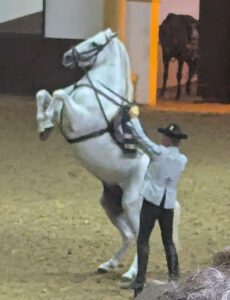
We arrived early when they first opened; we had to trade our vouchers in for tickets. We visited the museum, the old royal house, and watched some training in the paddock before going to the show. We visited the carriage house and stables, outside the gates of the school, before returning to our car.
I’m not an equestrian like Kelly but I have really enjoyed our visits to the Spanish Riding School in Vienna back in 2006, seeing the Lippizaner horses in Lipica, Slovenia in 2014, and now the Royal Andalusian school. The horses and their training are amazing.
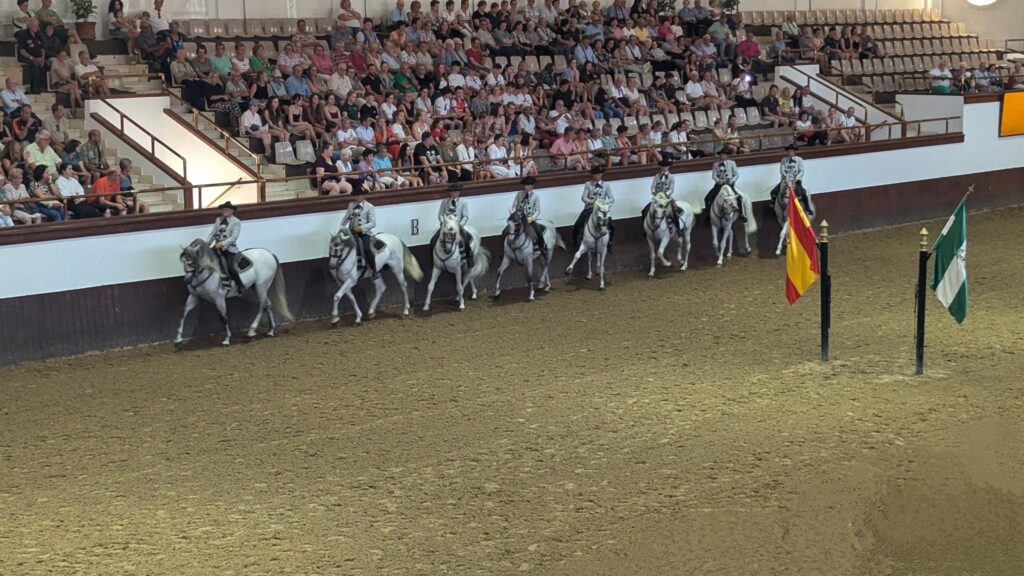
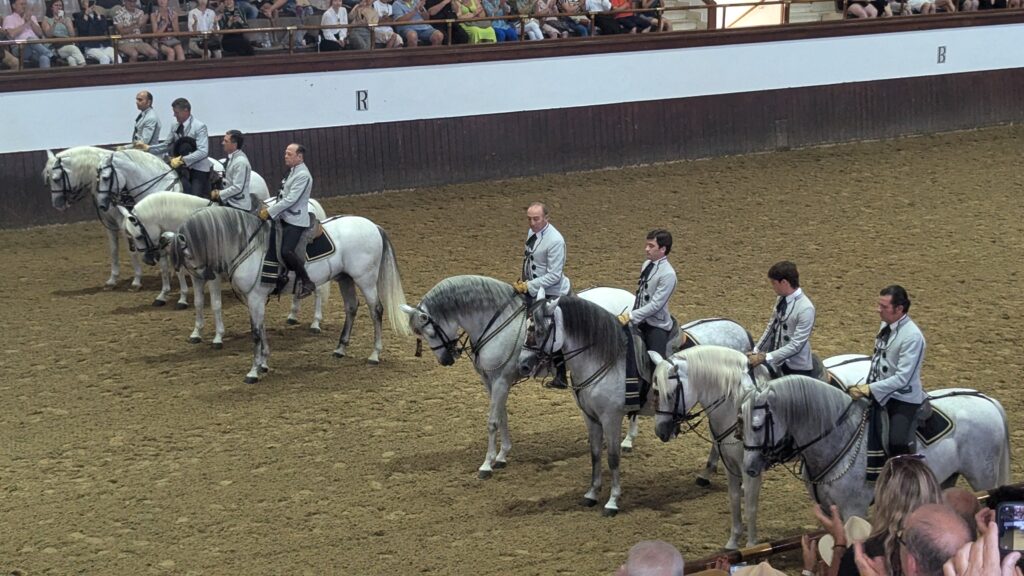
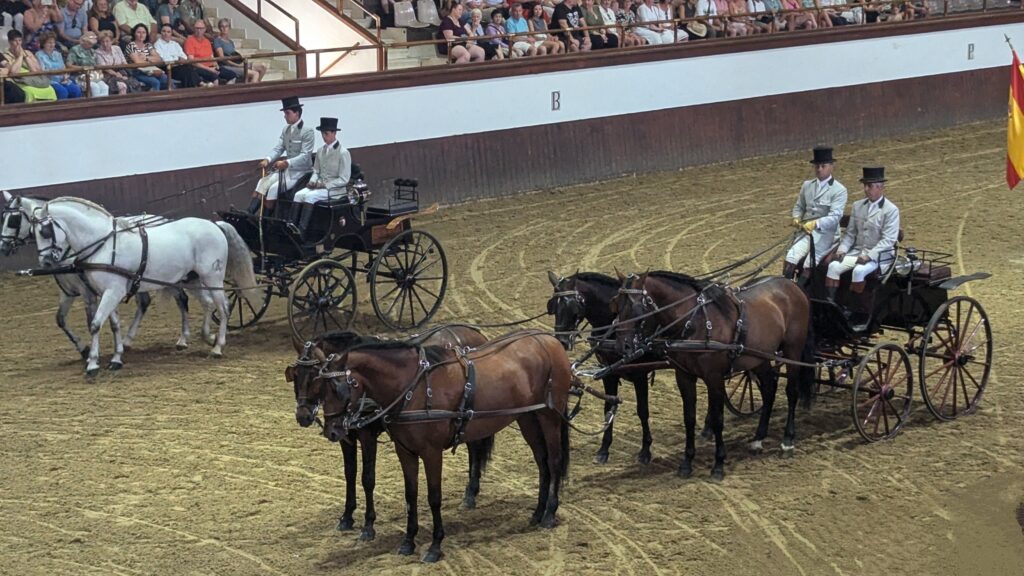
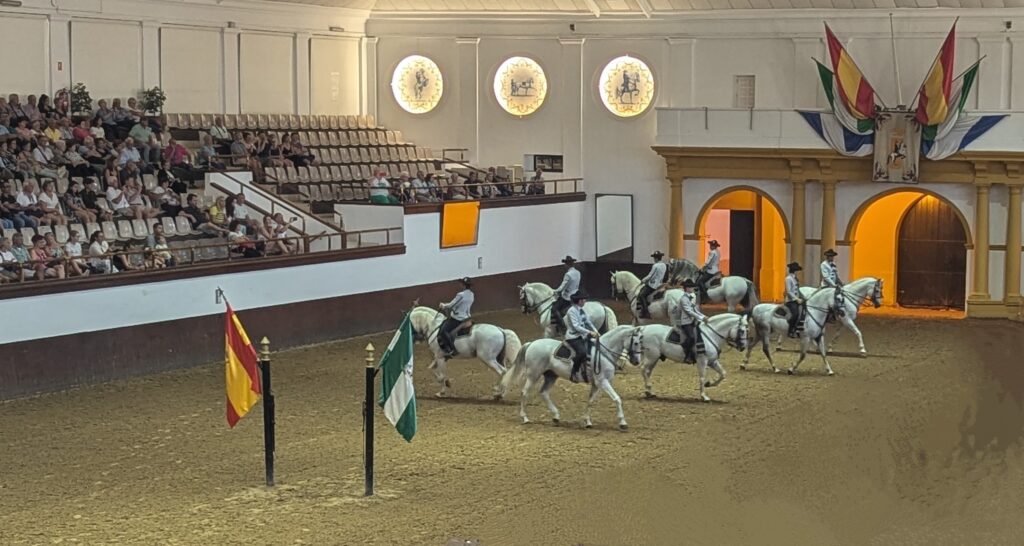
Cadiz
We went to our prepaid parking on the coast, then walked to our hotel. It was quite a walk with our big backpacks so we stopped at Parision 1870, splitting a Spanish tortilla and had a couple beers.
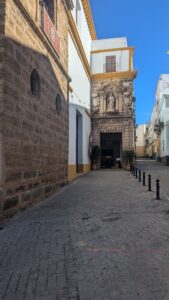
Hotel Boutique Convento Cadiz is a beautiful old building, attached to Iglesia Convento de Santo Domingo. It has a lovely courtyard, comfortable rooms but the bathroom was not nearly as nice as in Seville. I was expecting it to be like the pousadas I stayed at in Evora and Estremoz but all the common areas were quite modernized.
It’s not far from the Plaza San Juan de Dios. We walked through this beautiful square multiple times visiting other parts of the city; it is always very busy, there are lots of stores and restaurants, the city hall, a beautiful fountain and monuments. We ate dinner here the first night, but I don’t remember the restaurant name.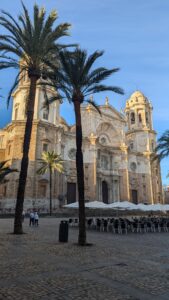
After dropping our bags, we went back out to explore. We went to the Plaza de la Cathedral. We were surprised the cathedral was still open for visitors after 1700. We paid for entry to the Cathedral de Cadiz, 8€ each. Free audio guide. The cathedral is magnificent. We visited all the chapels and altars and the sacristy, the columns are amazing. The pipe organ is really beautiful. We visited the crypts that have great statues of prophets and angels. We climbed the bell tower after leaving the church. From the tower we had great views of the ocean, the Roman theater, and over the entire city.
It has been undergoing restoration for decades and it will continue for more decades.
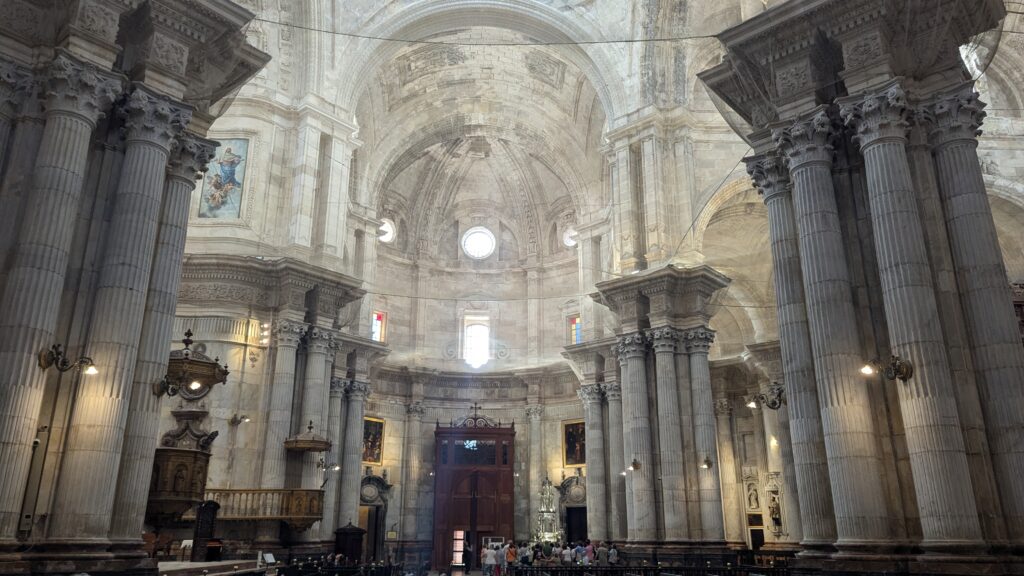
We visited the Santiago Apostol Church next. It’s on the plaza and was open late, too. We wandered through the streets on our way back to the hotel, seeing an old jail behind the police HQ, finding Plaza la Merced with a statue of a Flamenco dancer, and then the Centro Municipal de Arte Flamenco la Merced. We couldn’t see them but heard the music and their dancing.
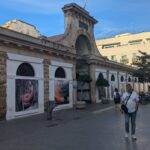
We visited the Mercado Central Cadiz the next morning and picked up breakfast sandwiches on our way to explore. It’s a great market in a beautiful building.
After breakfast we continued to Castillo de San Sebastián. It is a beautiful walk across the causeway but it wasn’t open despite the sign on the door and google maps saying daily at 0900 (Google also said “updated by this business 2 weeks ago”). A website I found later does say “temporarily closed”. Would have loved to wander inside.
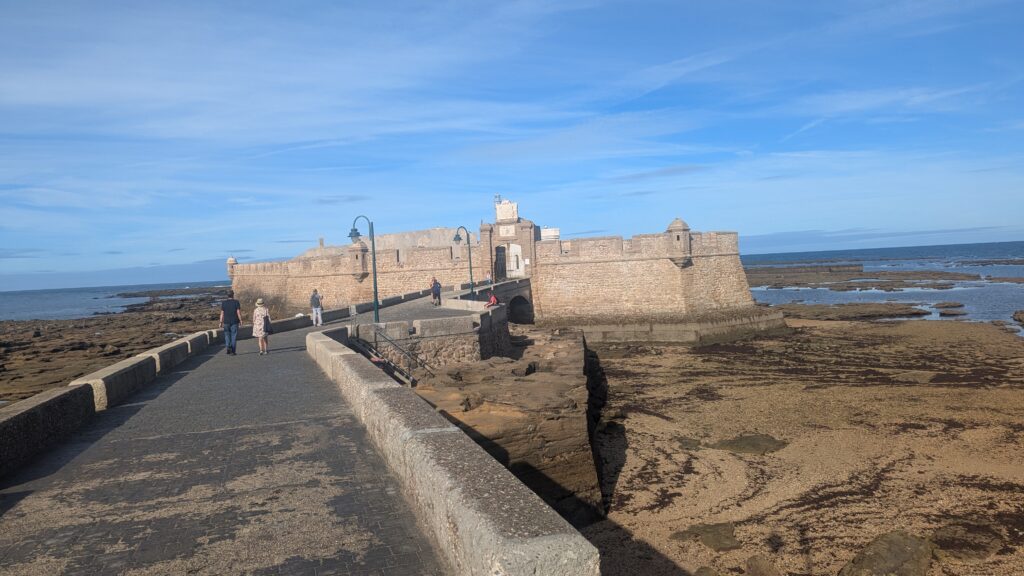
We walked to Castillo de Santa Catalina next. We visited the chapel, walked the walls for great views, there was an exhibit of the history of the explosion in 1947 from old WWII weapons, and an art exhibit of Cadiz 360.
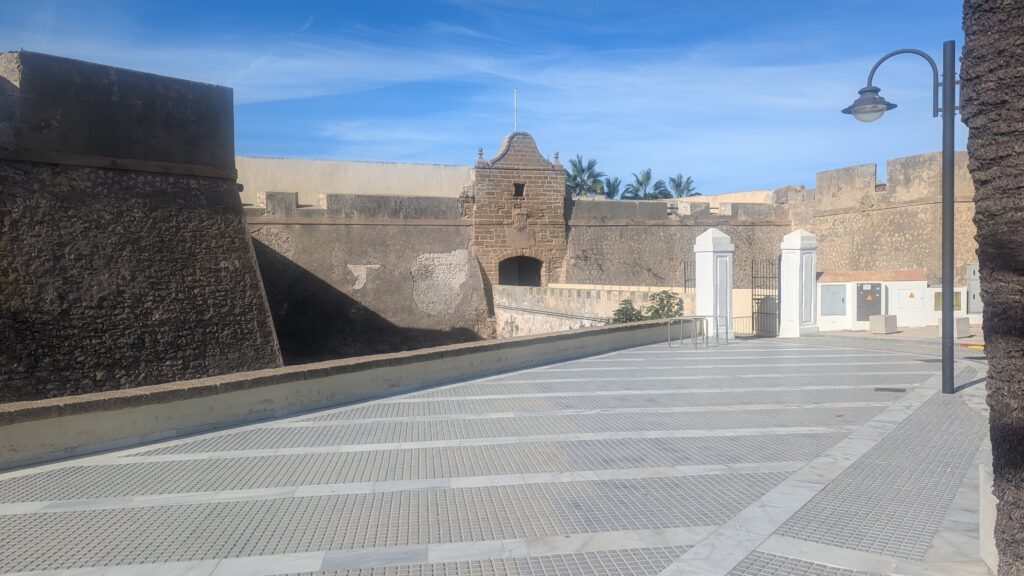
After the castle, we continued our walk through the Parque and Botanical Gardens, Parque Genoves. Beautiful. All before lunch! Yes, we had more sangria sitting in Plaza San Francisco.
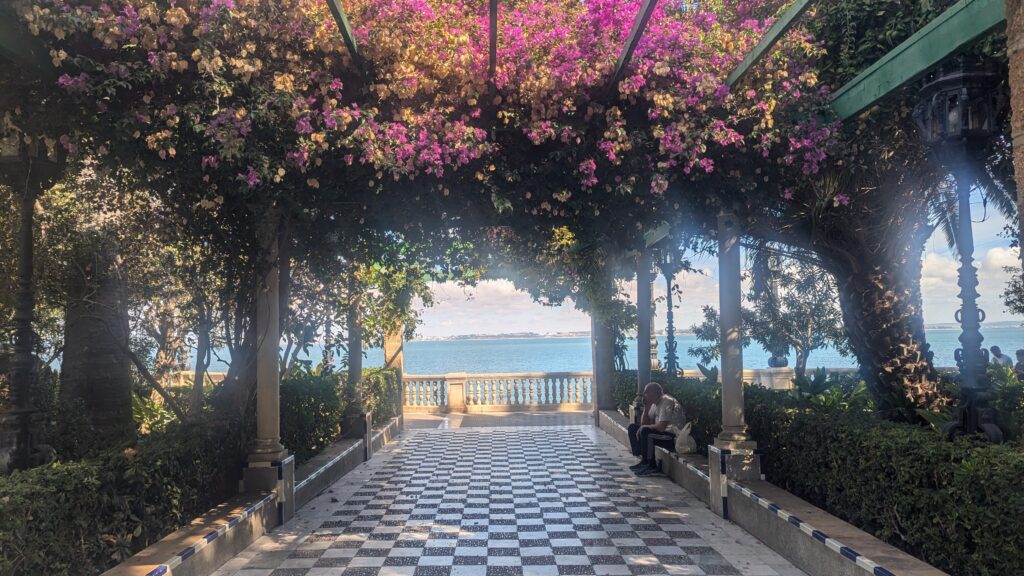
We visited the Teatro Romano de Cadiz after lunch. Free entry. It was found by accident in 1980 during an excavation for another building. We walked through the underground tunnels, used by the “nobility” and knights so they didn’t have to deal with the peasants while getting to their seats. The tunnels also lead to viewing areas to see the entire theater. There are a number of items excavated that are displayed on site. Highly recommend!
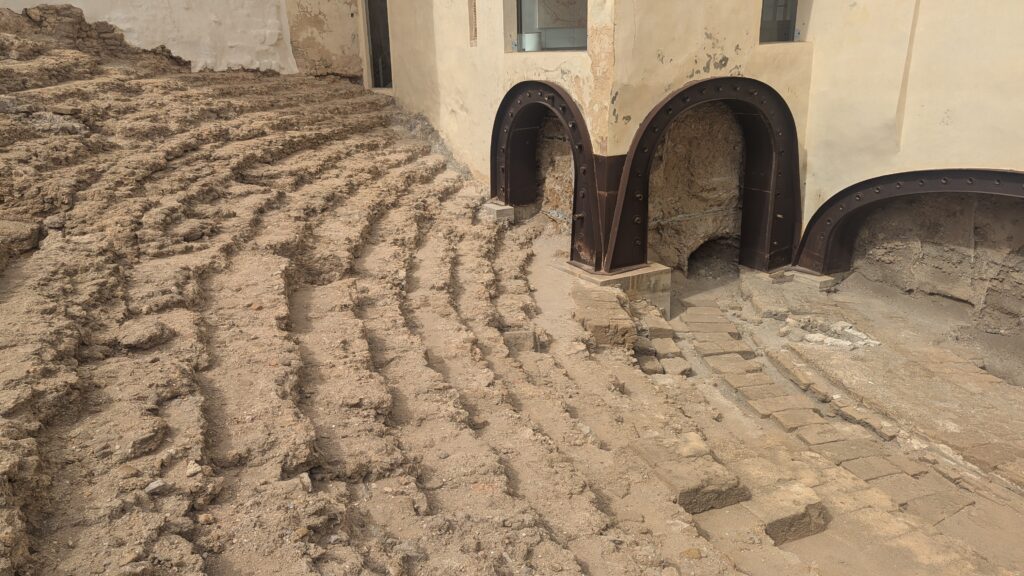
We ended the day with a visit to the Museum of Cadiz, a really great archeology museum. The main exhibit of the museum are the two Phoenician sarcophagi. It was interesting reading that the discovery of the male sarcophagus in 1887 led to the creation of the museum. The female sarcophagus was found in 1980. There are many, many beautiful exhibits however, statues, masks, a large mosaic floor, gold jewelry, beautiful glass bottles. We really enjoyed our visit.
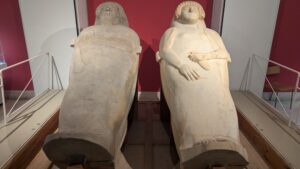
We wandered through the Plaza de Mina, on the way to the museum, and had dinner on the square later. We had some good pasta but I didn’t write down this restaurant, either. After the museum and dinner, we visited the Plaza Espana, saw the Monument to the Constitution of 1812 (it was the first constitution of the Spanish monarchy), then walked along the beautiful waterfront, along Avenida del Puerto.
- Vicens Artesans – a great selection of chocolates and other confectionary.
- Parision 1870 on Plaza San Francisco
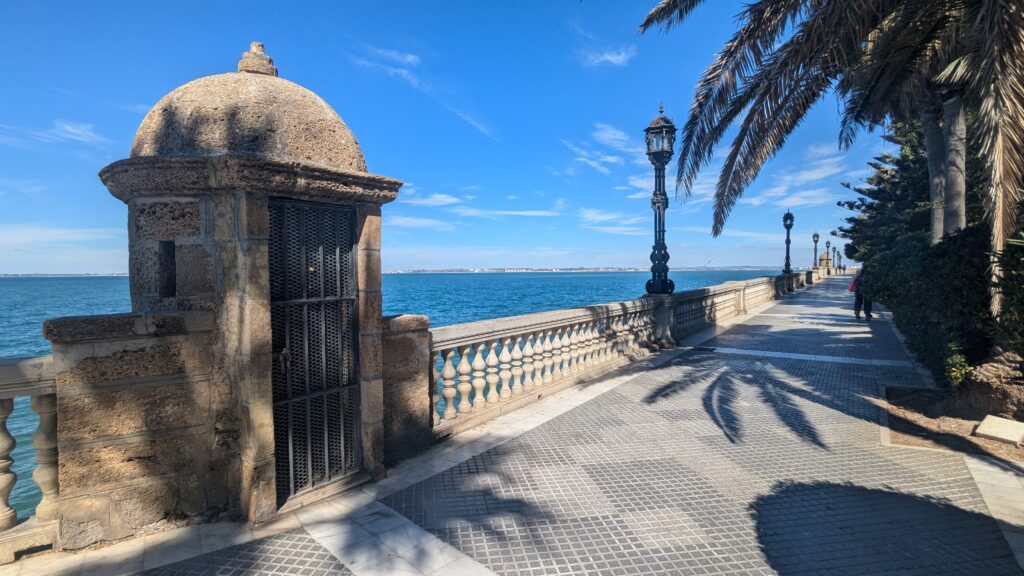
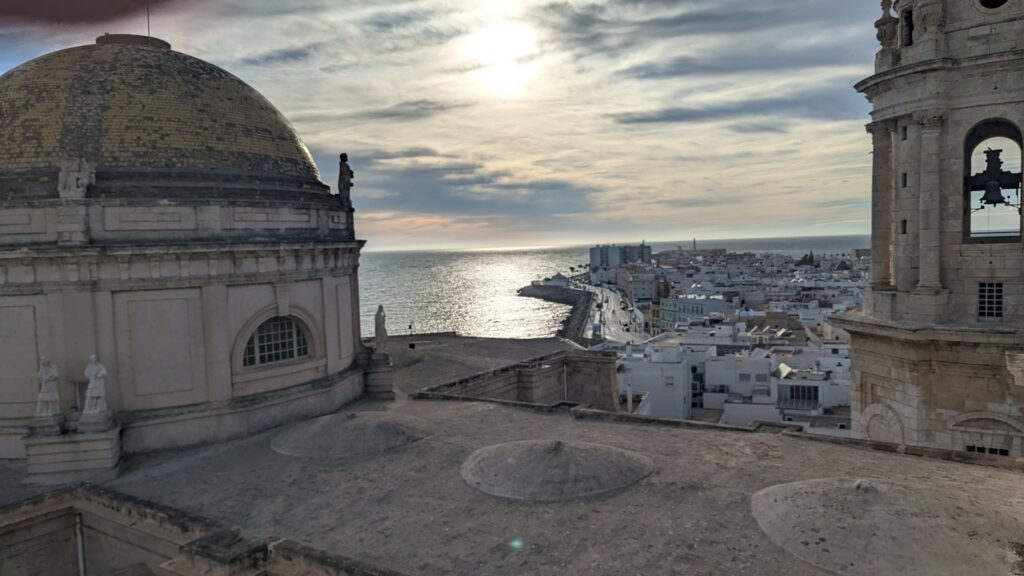
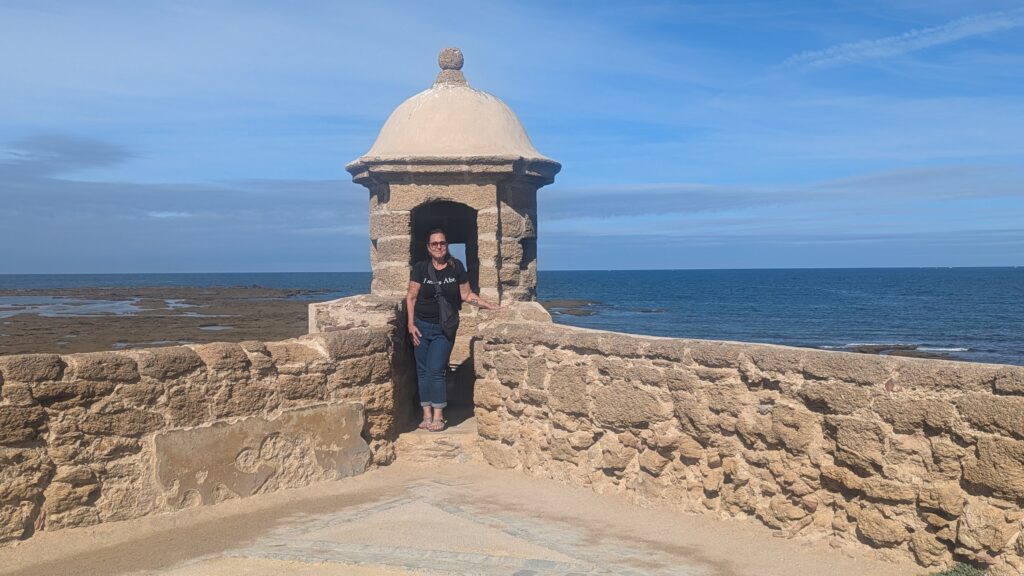
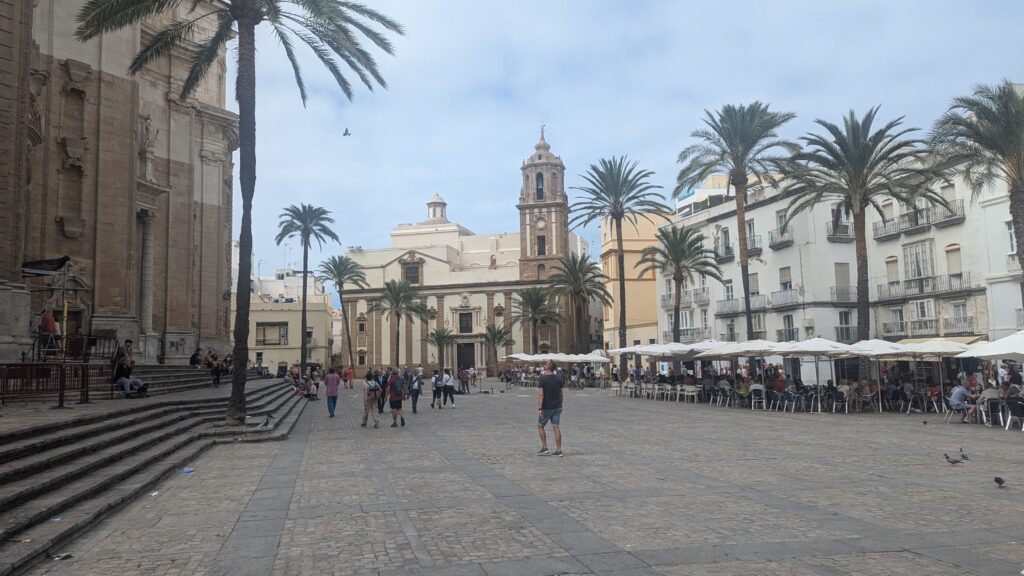
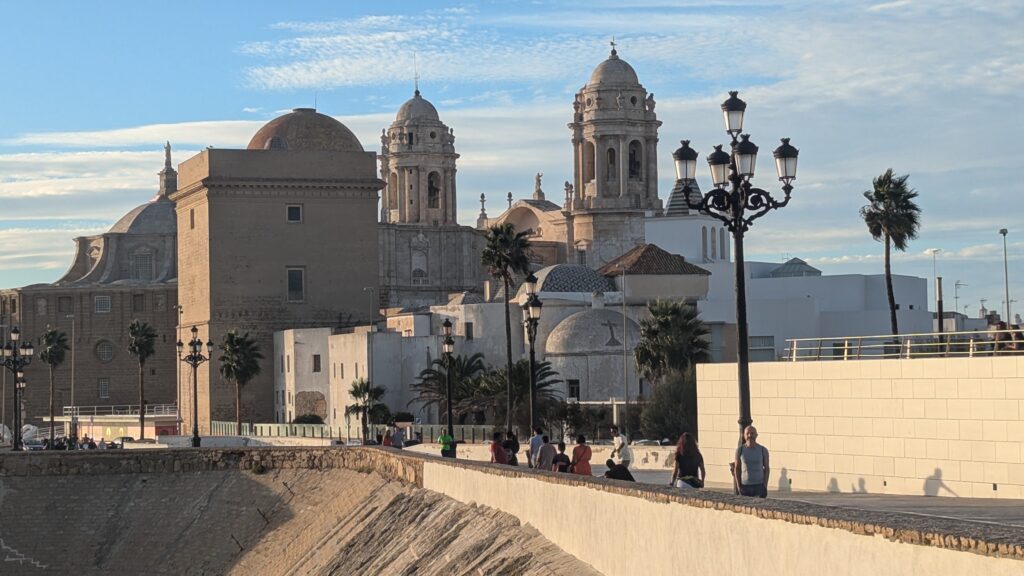
Malaga
We stayed in the Apartamentos Debambu. Nice rooms, helpful front desk staff, good location. It was well located close to old town, very walkable.
Our first stop was the Malaga Cathedral. It is part 9th century mosque, part 16th c., part 18th c. Still not finished, a roof was never put on to protect the domes so the inside ceilings are suffering water damage. We learned that fact later on our walking tour. We had audio guides, and saw the choir, organ, all the ornate chapels. We enjoyed walking around the outside too and noticing the very different styles of facades from the different building periods, Renaissance and Baroque and Gothic.
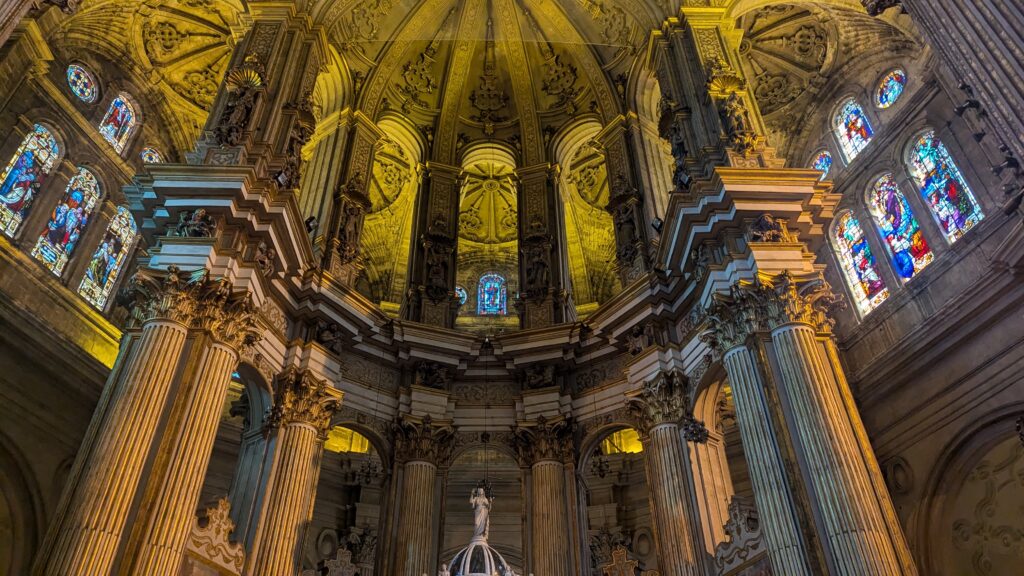
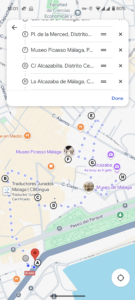 We picked up two different walking tours, both with GuruWalks. Our first day in town, at 1700, they had an English tour, called Malaga Monumental.
We picked up two different walking tours, both with GuruWalks. Our first day in town, at 1700, they had an English tour, called Malaga Monumental.
We met our guide in Plaza de la Marina. We walked down the beautiful pedestrian street Calle Larios, with beautiful facades, expensive stores, lots of restaurants. We saw the Plaza de la Constitución, the Plaza del Obispo.
We stopped to talk about the Cathedral and learned that not only was the roof not completed but that one of the bell towers wasn’t either. I hadn’t noticed this until the guide pointed it out. It is called “La Manquita” or “the one-armed lady” because of this. They are adding a wooden roof to protect all the domes but do not plan on finishing the tower.
We also visited the Plaza de la Merced and stopped at the Picasso Museum to learn about his home and school in the city. We ended at the Roman theater and Alcazaba.

The next day we scheduled the Free Tour Alcazaba & Roman Theater of Malaga. We were told to purchase the Alcazaba tickets online in advance for easier entry for the group, just 3,50€. We had a great guide, Jesus. We met in front of the theater. We learned that, just like in Cadiz, the Teatro Romano here was discovered by accident when the cultural center was expanded. Unfortunately, the visitor center was closed Mondays.
We continued to the La Alcazaba. Kelly and I had wondered about the difference between an alcazar and alcazaba so looked them up. We read alcazar is a fortified palace for royalty and alcazaba is a fortification for troops inside a walled town. It comes from the Arabic al-qasbah. Jesus asked if anyone knew what the word meant and was impressed we knew, but we said we literally just looked that up last night because we didn’t know.
We learned a lot about the various features and history we would not have known just wandering on our own. Like the other monuments, it was built during the period of “Al-Andalus”, the Muslim ruled area of the Iberian Peninsula. It was started in the 11th c. and was modified up to the 14th century. It is one of the best-preserved fortresses in Spain. The Alcazaba is also connected by a walled corridor to the Castle of Gibrafaro. We could see the path up but didn’t know how to access that.
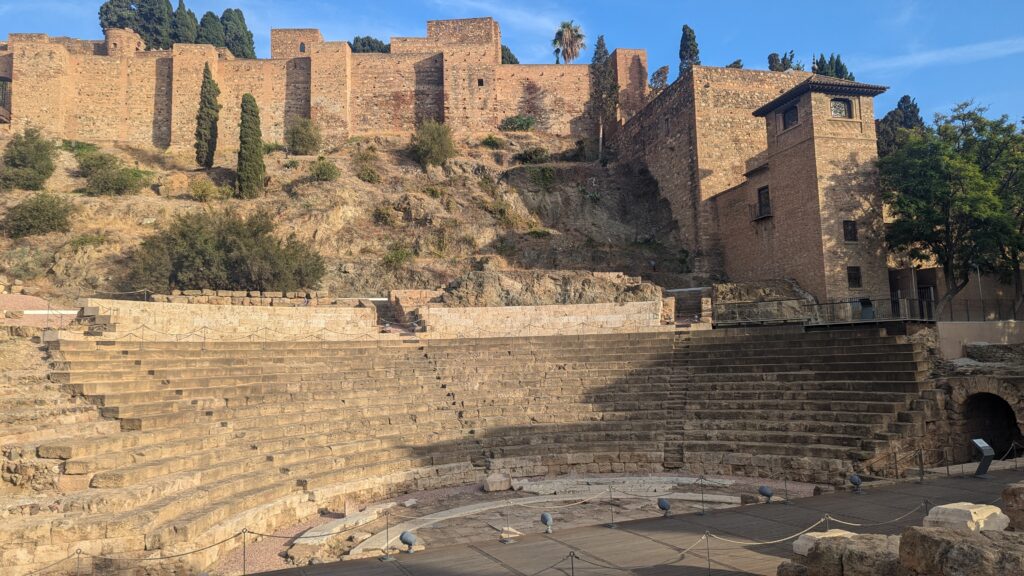
Malaga is Picasso’s hometown. We had purchased tickets to the Picasso Museum in advance, for 1500. The line is always long but moves quickly when they let each timed group in. You have to leave your bags with the bag check. There are so many great paintings, ceramics, statues here. All items were donated by his family to the museum. There were signs for each exhibit, with the name of the piece, date, and more. It is a really great museum. We spent about 90 minutes here; there was also a special exhibit of photographs of Joel Meyerowitz.
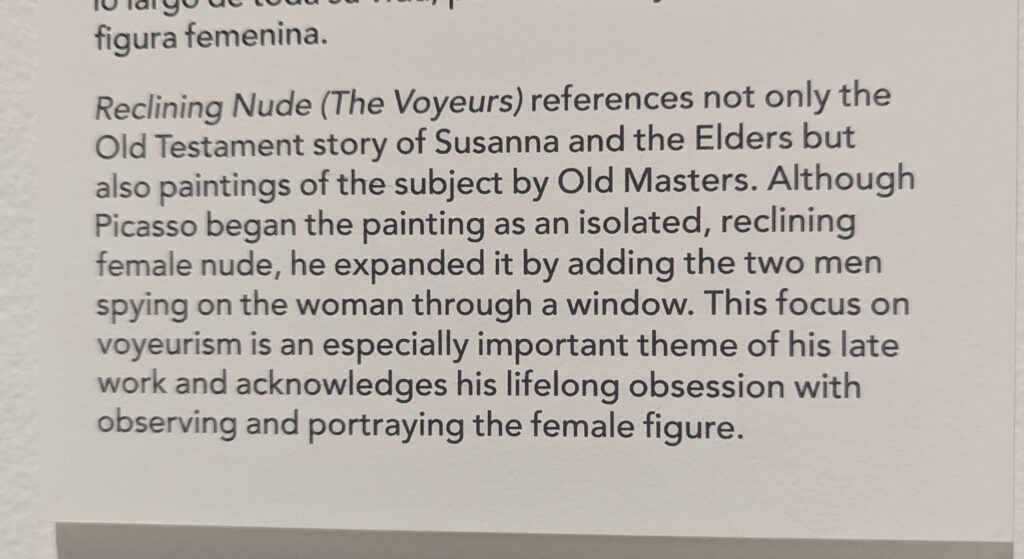
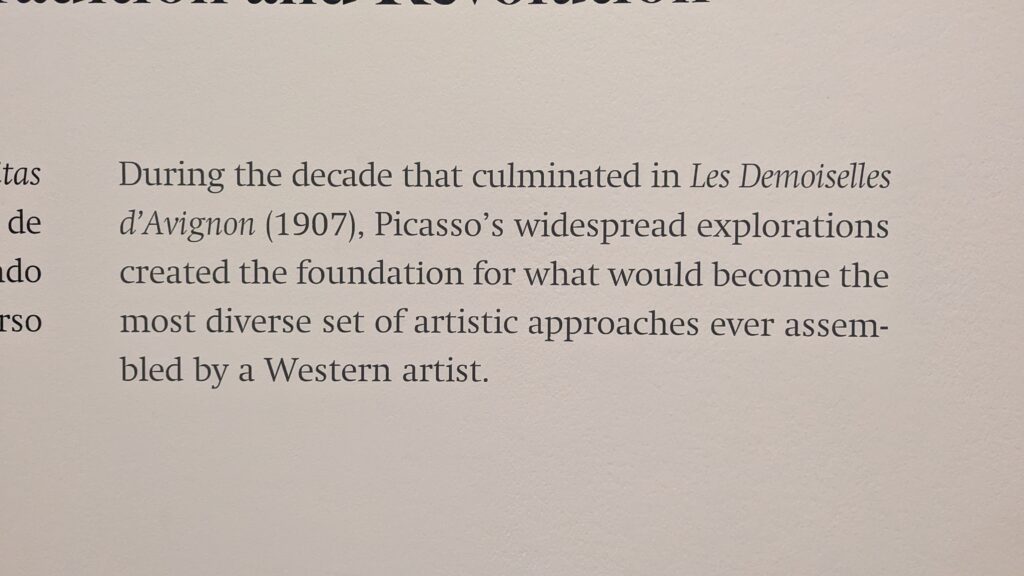
After the museum, we found the correct bus to get us to the Castillo de Gibrafaro. There is a small room of items found on site but mostly we just enjoyed wandering the ruins, gardens, and enjoying the views from the walls of the Alcazaba, city, and marina. We walked down the paths instead of taking the bus, enjoying the Parque de Malaga and the city lights on the facades of buildings as we walked through the city center. We found d’Platos for dinner before returning to the hotel.
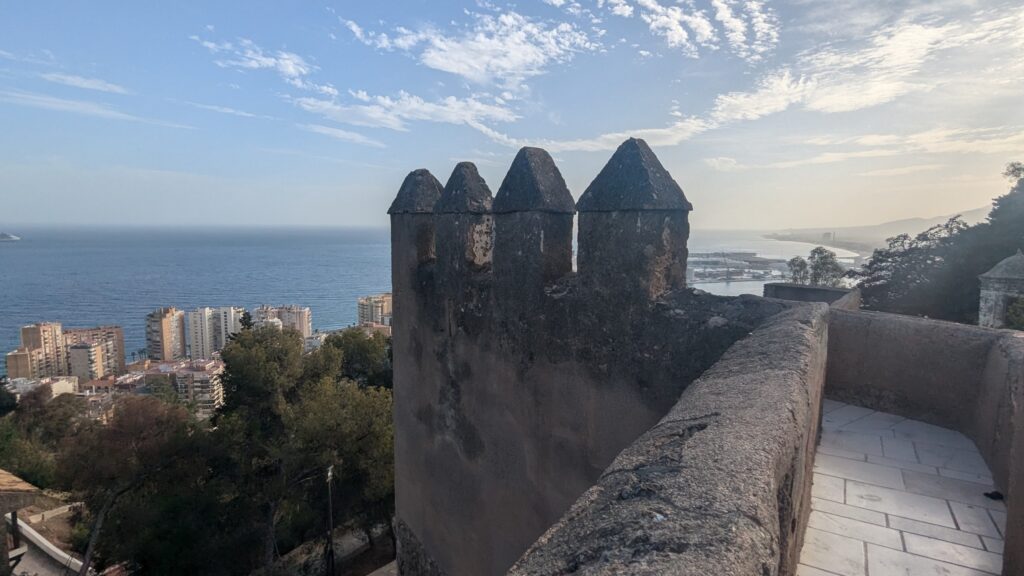
- Casa Lola We had some excellent tapas here. We asked if many were shareable and the server said they were just a bite/enough for one, but almost all of them could have easily been shared. Regardless, all were delicious. We had the Africaish, Mini Chicken Kebob, Juanillo, Floor Finger Suckers and shared the fried potatoes with spicy sauce.
- D’Platos
- Casa Mira we stopped in for ice cream here, both our guides told us to try it. There are two locations. One, always busy, on Calle Larios and the other is on Calle Císter, close to the Museum of Malaga.
- Brunchit we had an excellent breakfast before heading to Granada. Great selection of eggs, and other dishes. Close to the market.
- Tatanegro just in front of the cathedral, great place for a drink or dinner.
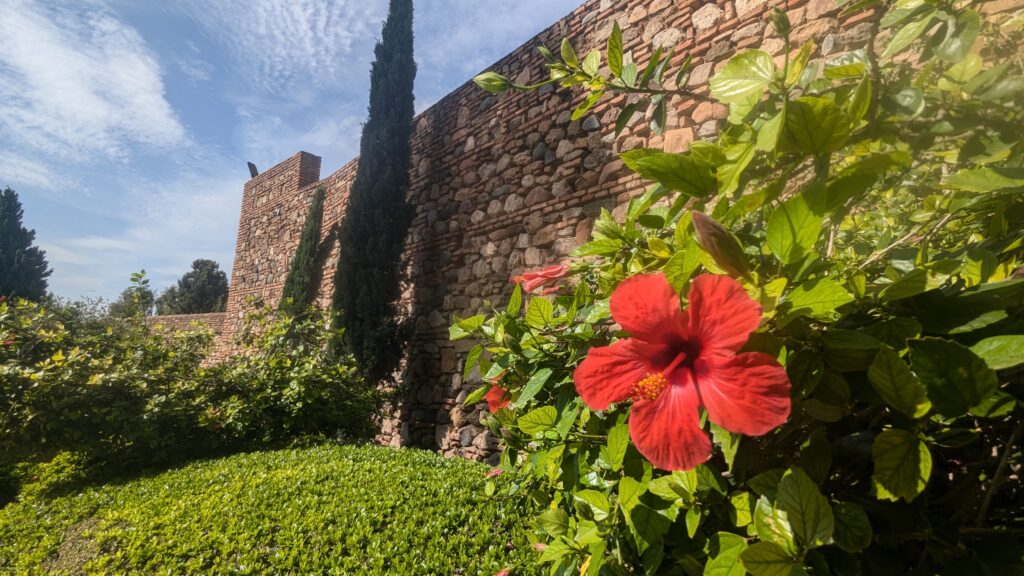
Granada
We took a 20 minute detour on the drive to Granada. We had Nerja in our original itinerary but cut an overnight stay; we still wanted to see the Aqueduct Eagle. Easy access off the highway and there were pullouts from both directions to get photos. The aqueduct was built in 1880, designed to look like a Roman aqueduct. It still carries water to Nerja. Definitely worth a quick stop, it’s really beautiful.
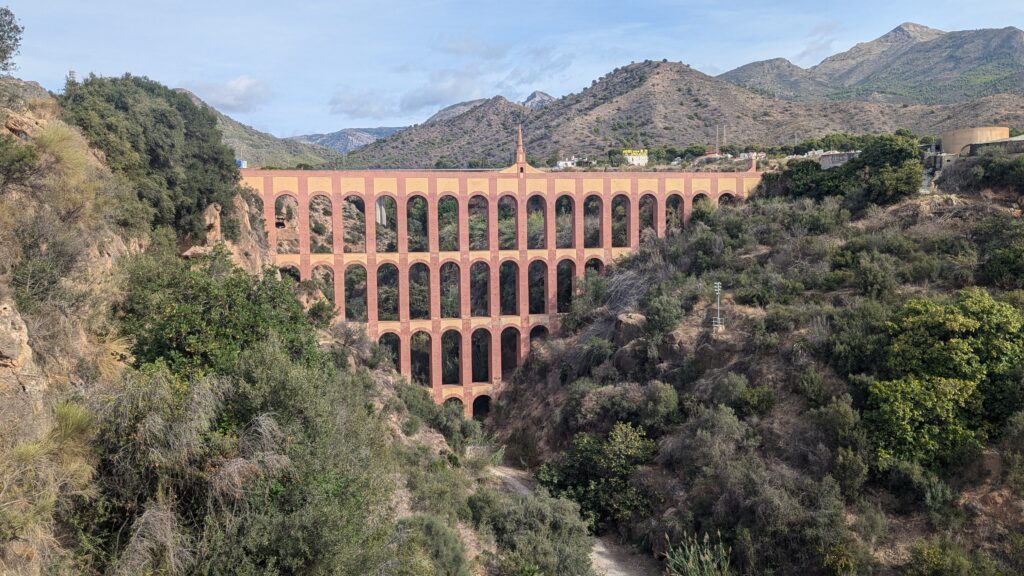
We stayed in the very nice Mosaiko Homes Catedral Granada. I loved the rooms, the large space included a bedroom, dining/living area, great bathroom and big shower, gorgeous tile floors. They brag about their technology but I wasn’t impressed with the online keys. All communication was via What’s App. I have a Portuguese number with a Vodaphone SIM but wondering about visitors who don’t have access to cell service and count on free WiFi while traveling. Kelly got some physical keys and they came in handy. I would have much preferred just a keypad with assigned PIN code for both doors, like I had on many of the AirBNBs I’ve stayed in. Every time I opened the link I had to accept their terms & conditions. Not user friendly.
We visited the huge cathedral after checking in. The Granada Cathedral is stunning. The stained glass, the dome, the altar, doors, all incredible. Beautiful facade.
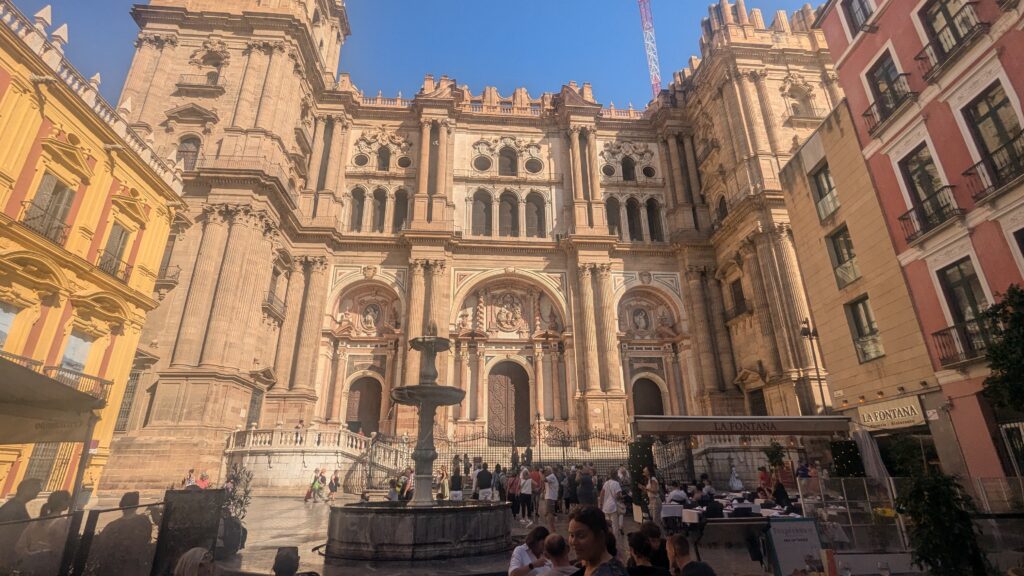
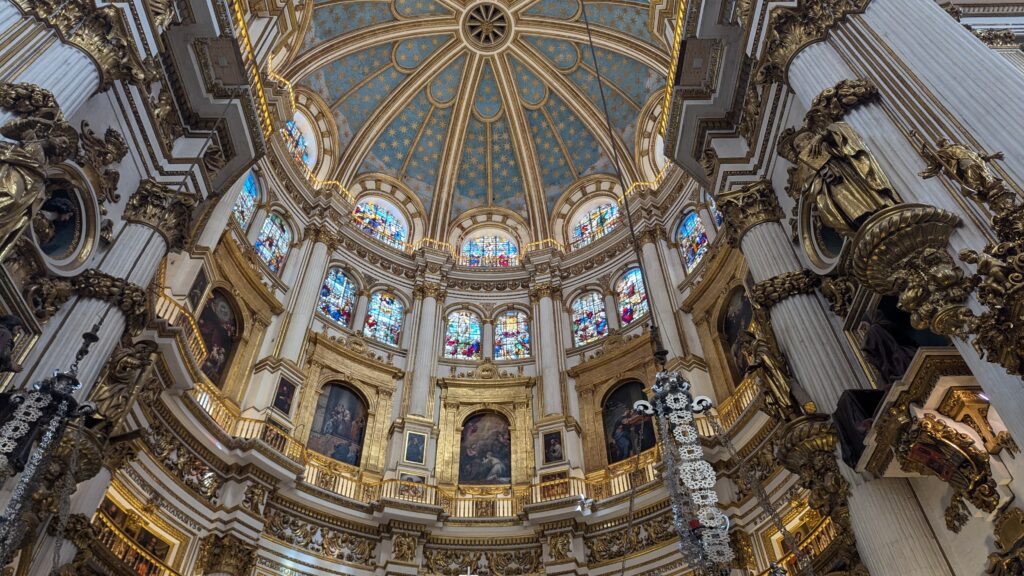
We booked another walking tour with GuruWalks, the Essentials of Granada. We started at the old city gate, Elvira Gate. The gate was part of the 11th c. walls and rebuilt in the 14th c. as part of the Nasrid extension.
We walked up the steep hill from the gate to see San Miguel Bajo then went on to the Monastery of Isabel la Real. Our guide, Marta, ordered some cookies from the nuns for us. We visited the Mirodor Saint Nicholas for wonderful views of the Alhambra.

We visited the Carmen de la Victoria. “Carmen”, Spanish for “karm”, is a small estate or vineyard and place of retreat. There are many “carmens” throughout Granada, there is even a tour of them. We saw the small garden, it also had lovely views of the city. Finally we went down the Paseo de los Tristes, or Walk of the Sad, where funeral processions went to the cemetery. We ended at the Royal Chancellory on Plaza Nueva. It was a great walk and we saw a lot of the city we probably wouldn’t have seen otherwise.
We also learned why the pomegranate was everywhere. I did not know Granada was Spanish for pomegranate. Pomegranates were brought to Spain by the Phoenicians in 850. King Ferdinand and Queen Isabella chose the fruit as a symbol of their final victory over the Moors, which took place in Granada. Once you see a few pointed out, you see them everywhere on signs, manhole covers, churches, the city crest.
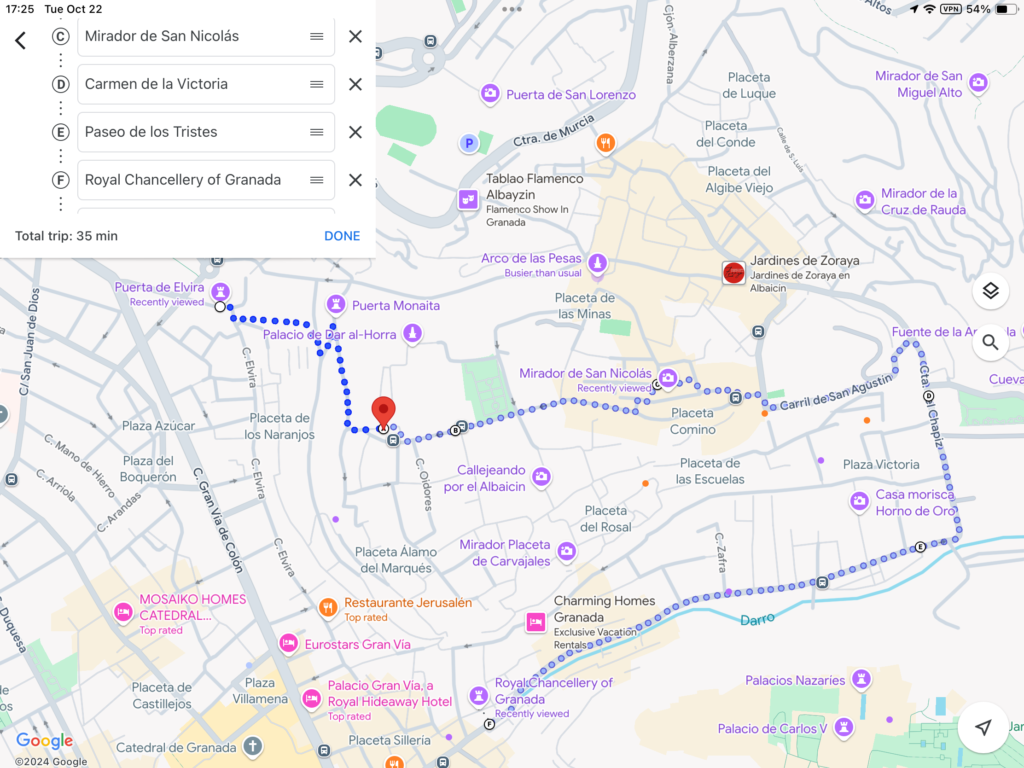
The next day, we decided to see more of the city before heading to the Alhambra. We visited the Corral del Carbon or Dobla de Oro, 14th c Moorish Ruins. The site is listed as part of the tickets to the Alhambra, but actually this is a free site.
We visited the old cisterns, or Aljibe del Rey. We didn’t realize they had specific tour times, we were just told they opened at noon for visitors. Google says they open at 0900 but that is for school groups only according to Marta, our tour guide. Regardless of arriving after noon, for the tour, we were let in to see the site. The biggest cistern of el Albaicin is under the patio. There are also beautiful gardens.
We also stopped by the Palace de la Madraza, another Moorish palace from the 13th c, now a cultural center for the university. There are lecture and exhibit rooms for the university, but we could visit both the ground floor and 1st floor and visited the Salón de Caballeros XXIV, from the early 16th century.
Like with the Alcazar in Seville, it was essential to purchase La Alhambra Granada tickets in advance. We also looked up ‘alhambra’ when looking at alcazar and alcazaba. Alhambra means ‘red one’.
I couldn’t go to Andalusia and not see the famous palace and fortress of Alhambra, considered one of the most famous building of Islamic architecture. Begun in 1238 by the founder of the Emirate of Granada, Muhammad I Ibn al-Ahmar, it became a UNESCO World Heritage site in 1984.
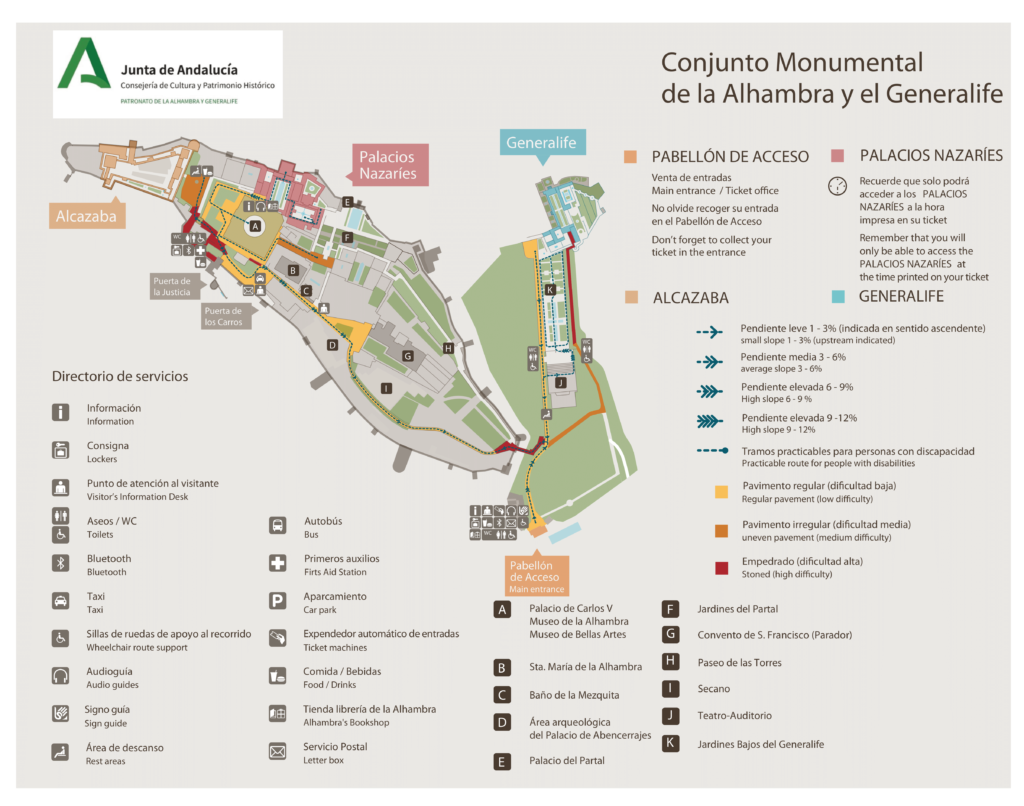
We purchased tickets to the Nasrid Palaces, with timed entry at 1730. We had all day to visit the other sites on the huge complex. We took the bus up to the site, arriving after 1400.
They didn’t offer paper maps like I was hoping but they had QR codes at the gate for an online map and audio guide. We really didn’t even need the online map, however, as the entire site has very good directional signs.
We visited the Palacio del Generalife first. There are beautiful gardens, lots of fountains, and there are great views of the Nasrid Palaces from the terrace.
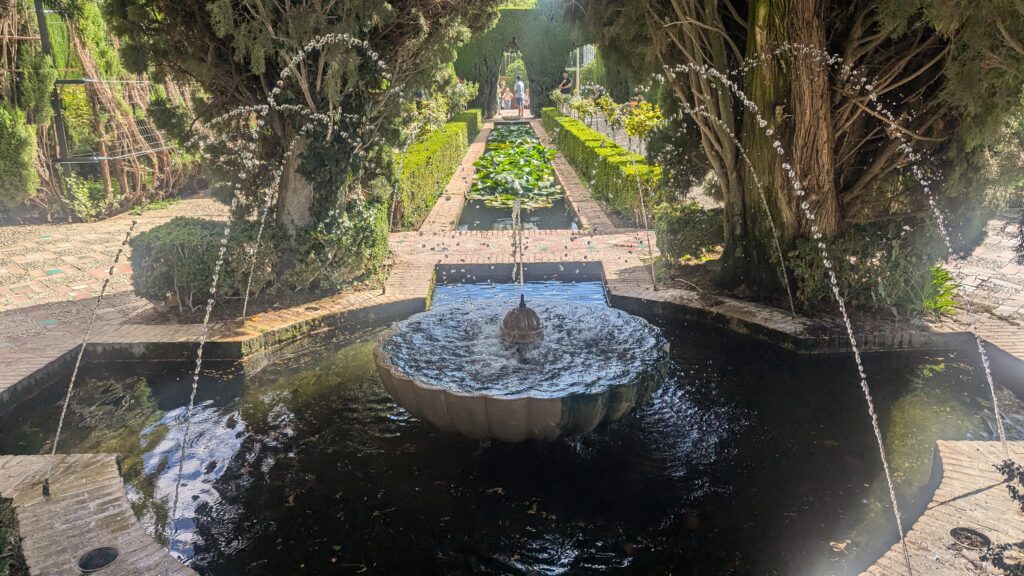
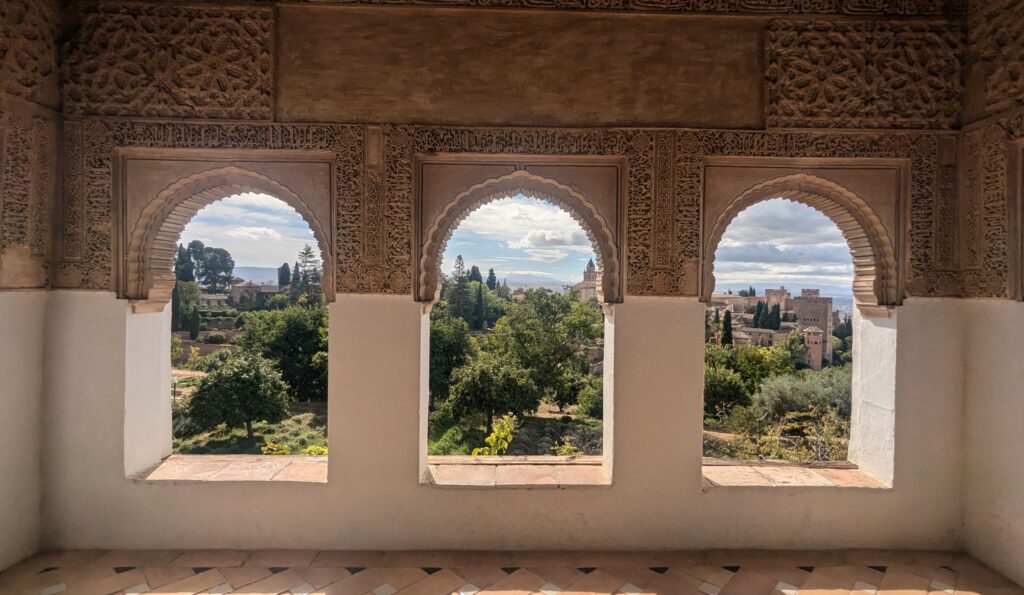
We went back towards the entrance then walked along the archeology ruins on the outer wall, saw the Bano de la Mezquita, or the Bath of the Mosque, the Paseo de las Torres, and visited the church, Santa Maria de la Alhambra before getting in the line for the Nasrid Palaces.
We spent about 90 minutes inside. Every bit of the palace, the walls, windows, doors, ceilings is decorated. The Court of the Lions is part of the site, and beautiful gardens, courtyards, and fountains, too, along with views of the Generalife through the windows.

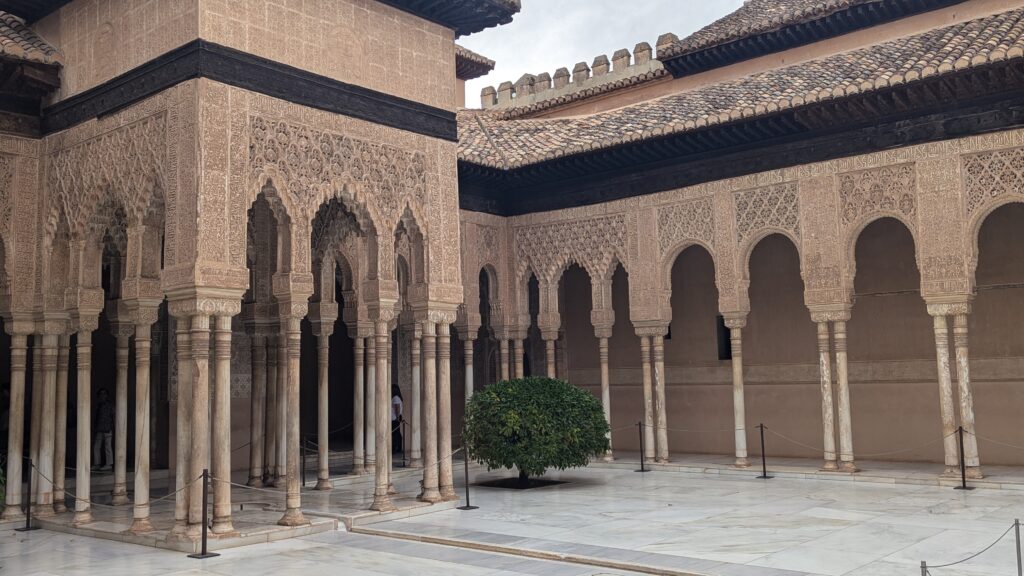
We visited the large circular Palacio Carlos V and the Alcazaba, or fortress, after the Nasrid Palaces.
We took the bus back to the city, getting out at the Plaza Isabel la Católica. We walked through here many times as we visited parts of the city. There is a large fountain and monument with Isabel and Columbus.
- Los Manueles there are several restaurants around the city, we stopped at the one by the Cathedral, on Plaza de Bib Rambla, for drinks. Good selection of food.
- Minuit Pan & Cafe we had a good breakfast here, they offer a large selection of coffees.
- Verde Rama we had an excellent vegetable paella here after a long day of exploring. Nice outdoor seating.
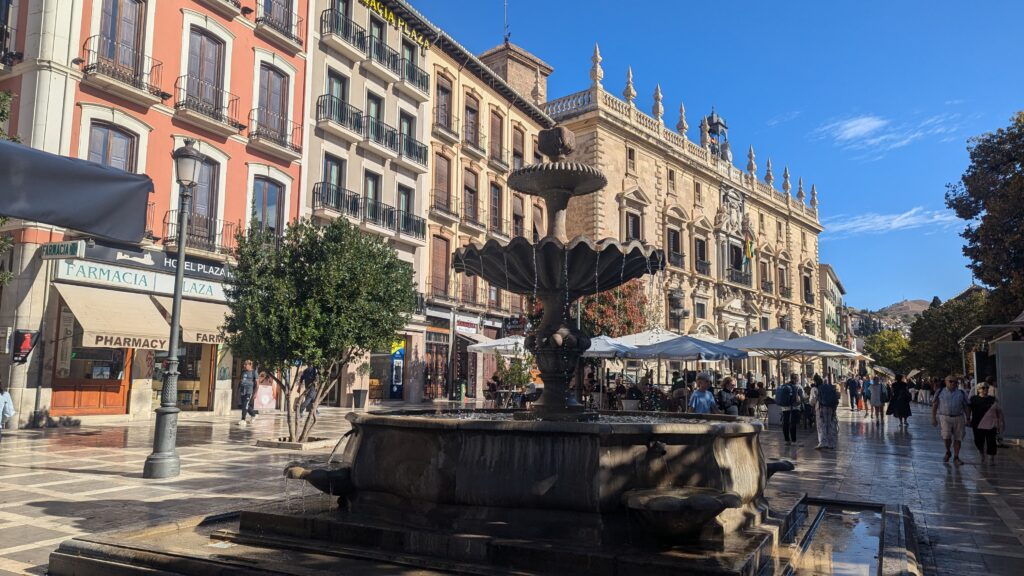
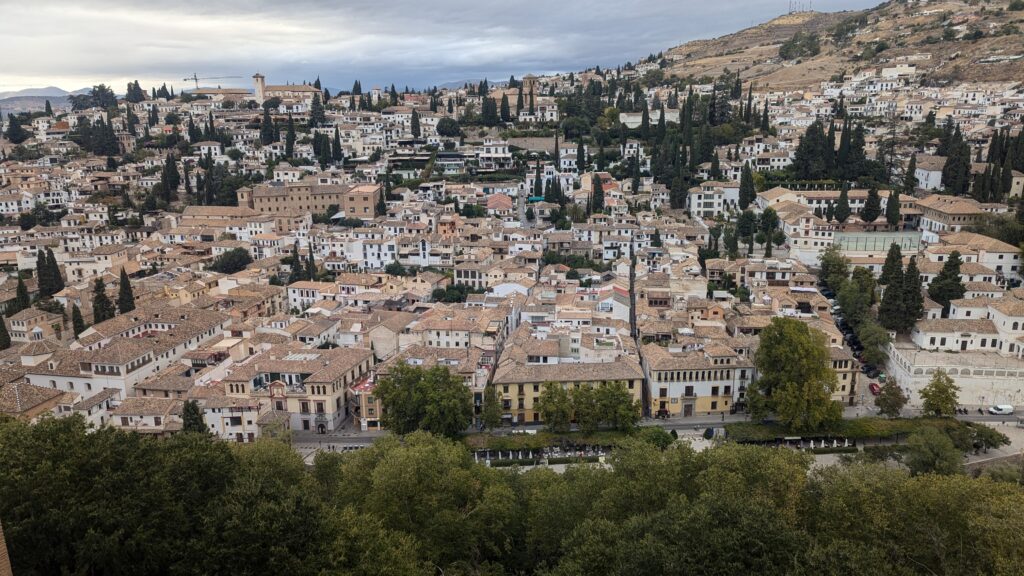
Cordoba
We only stayed one night in Cordoba so booked a Get Your Guide, 4-hour tour to see as much as possible during our short time here. It included the Jewish Quarter, Synagogue, Mosque, and Alcazar. It started at 9:50 and we had a 2-hour drive (on 2-lane winding roads) from Granada so got up early to get there on time. We went to our hotel, Parador de Cordoba, leaving our car. We caught a taxi downtown. We checked in late afternoon after a full day in old town. Lovely and large room, very comfortable, beautiful grounds. We spent 1/2 hour or so looking at the gardens and pool. Would love to have stayed longer, it is really a beautiful hotel.
After worrying about arriving on time, we were plenty early, checked in and had time to visit the cafe in the Hotel Eurostars Maimonides, just across the street. We had some good ham and cheese croissants.
Our first stop was the Alcazar of the Christian Monarchs. We visited the ruins, a room of amazing mosaics, and spent time in the gorgeous gardens with beautiful fountains and a large statue of Ferdinand, Isabel and Columbus.
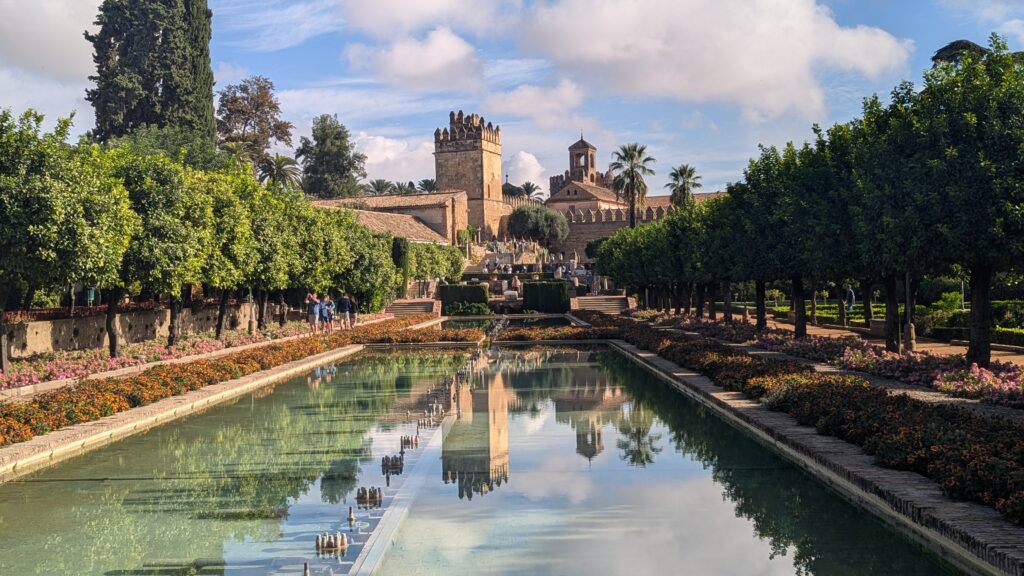

Our next stop was the Jewish Quarter, in the medieval quarter of the city. We visited the old synagogue, one of the best preserved in all of Spain. We saw the statue of Rabbi Moses Ben Maimon, better known as Maimonides, who was born in Cordoba. We visited Calleja de la Hoguera or Alley of the Bonfires, and heard more about the Jewish population and how they were forced out of Spain.
We went to the Palacio de Viana and enjoyed many of the beautiful patios and narrow alleys full of flowers and fountains.
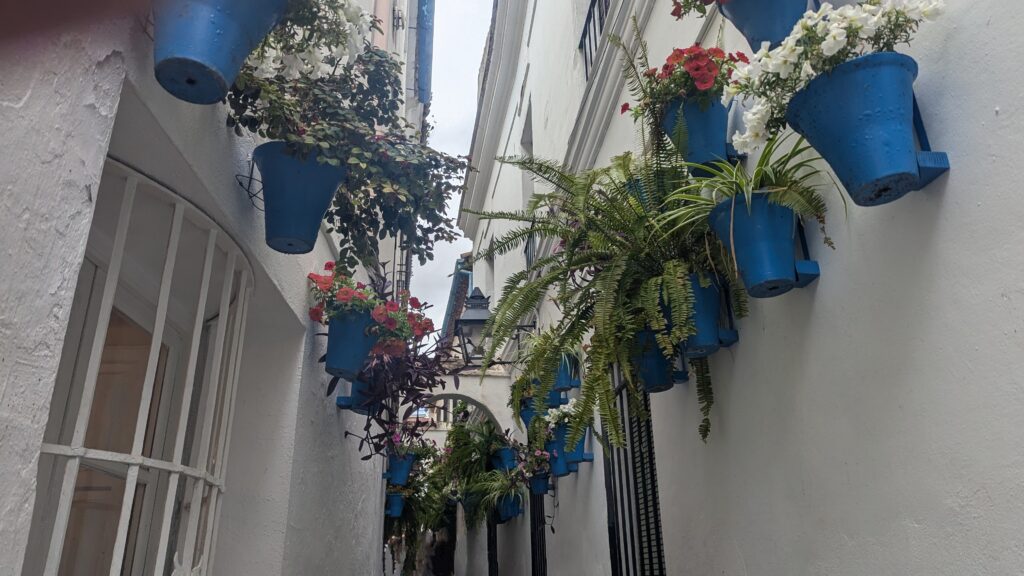
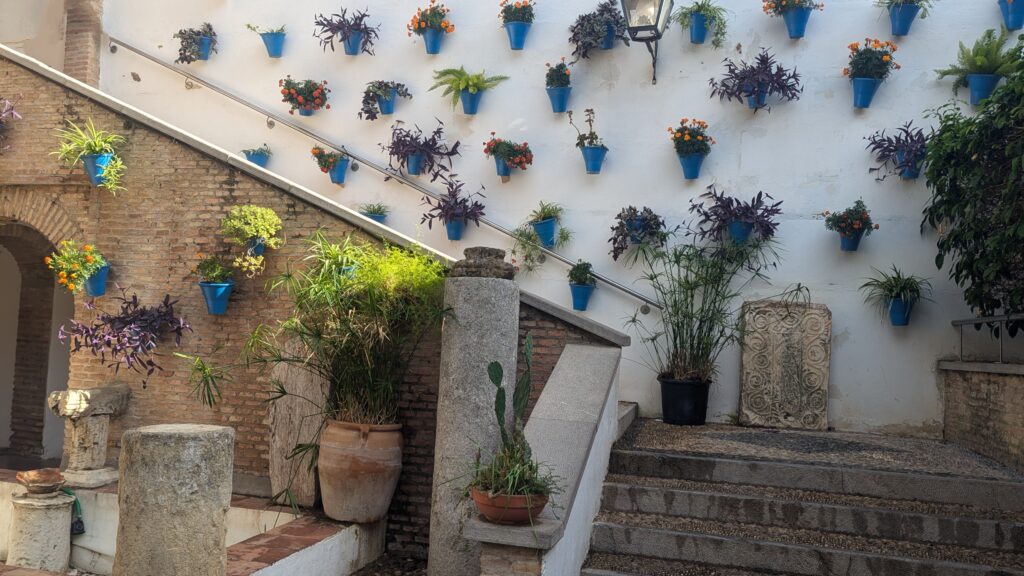 Our last stop of the tour was the Mezquita-Cathedral of Cordoba. Mezquita is Spanish for mosque, the building is also known as the Great Mosque of Cordoba, or the Cathedral of Our Lady of the Assumption.
Our last stop of the tour was the Mezquita-Cathedral of Cordoba. Mezquita is Spanish for mosque, the building is also known as the Great Mosque of Cordoba, or the Cathedral of Our Lady of the Assumption.
We met a different guide here who was a specialist on this building. The building is huge and incredibly beautiful. It has been a UNESCO World Heritage site since 1984. The Great Mosque was built in 785 under the reign of Abd al-Rahman I, founder of the Emirate of Cordoba. It was expanded multiple times through the 10th c. The mosque was converted to a cathedral in 1236 when Cordoba was captured by Christian forces. There were no major changes until the 16th c. when a large renaissance cathedral nave was built in the center of the building. The minaret added in the 10th c. was converted to a bell tower and new facade built around it.
The facade of the cathedral isn’t nearly as attractive, many of the arches were covered outside to add chapels inside. During various restorations, archeologists have found some of the previously hidden Islamic-era elements.
I found this on link on Wikipedia when looking up dates and thought it was very interesting: Ecker, Heather (2003). “The Great Mosque of Córdoba in the Twelfth and Thirteenth Centuries”. Finally, adding to present difficulties in perceiving the sequence of post-conquest restorations, additions, and demolitions is the fact that the cathedral has to a certain extent been “re-islamicized”: twentieth-century restorers have removed medieval sarcophagi and other structures from around the mihrab area and along the qibla wall, erected a sort of maqsura structure around the same area, and replaced the ceiling with one based on that of the Great Mosque of Qayrawan.
Catholic mass is celebrated here daily. This is a truly unique and beautiful building, I would have liked to spend another hour just wandering after our tour was done.
I don’t recommend this tour, we gave it a low rating on GuruWalks; two reasons, they take 30 people on the tour, the maximum allowed by Spanish law but it is way too many people for the narrow streets and patios in Cordoba. Then we all had headsets but both guides wore their microphones around their necks instead of over their heads, and every time they turned the sound cut out. Glad to see so much of the city but I would try and find a different tour next time.
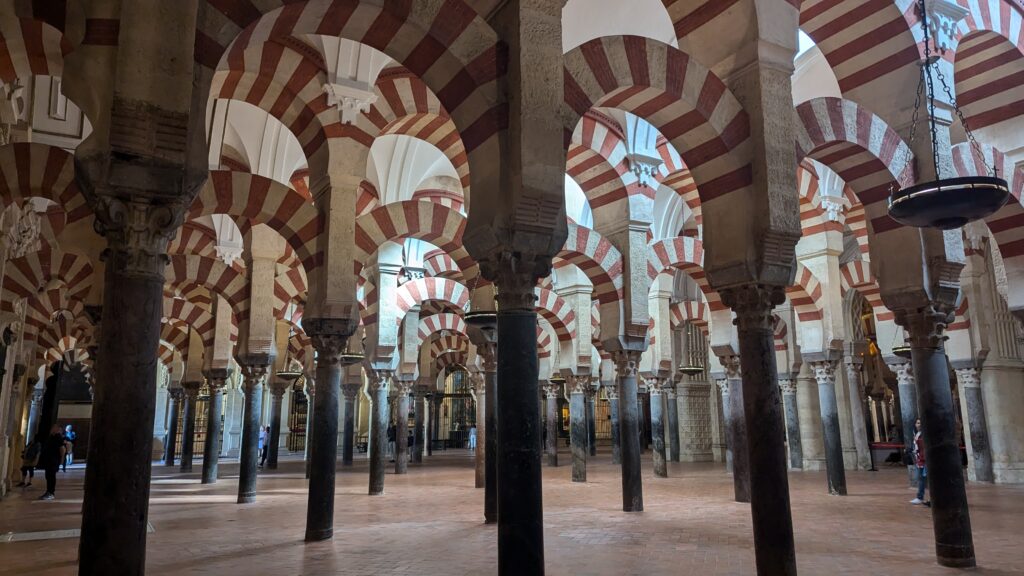

After our walking tour, we stopped for some sangria then walked towards the river Guadalquivir. We saw the Gate of the Bridge or Puerto del Puente. We crossed the river on the Roman Bridge or Puente Romano de Cordoba, built in the 1st c. It has been restored many times over the centuries and only two of the arches are original.
The Torre de la Calahorra, now a museum, is on the other side of the river at the end of the bridge. I wish we had made time for a short visit, as it looks interesting. We continued along the river, visiting the Parque of the Miraflores before returning to old town by the Puente de Miraflores. This gave us a great view of the Roman Bridge. We found a good place for dinner on the way back to the hotel.
We had selected a hotel with parking, outside of the city, to make it easy to get to the Seville airport as Kelly had a 0900 flight and I dropped her off around 0700 then headed back to Lagos in the rain. We had perfect weather the entire trip, however.
Loved my first visit to Andalusia! Interesting history and beautiful sites.
- La Alqueria I had the special of Cordoba, the flamenquin, a traditional dish of ham and pork loin. Delicious. Lovely location by the Roman Bridge.
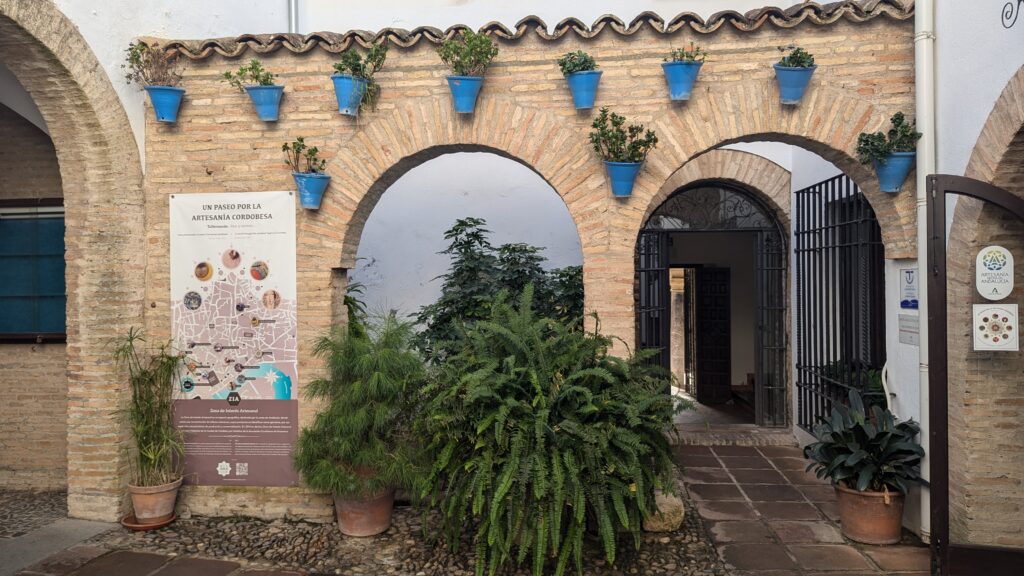
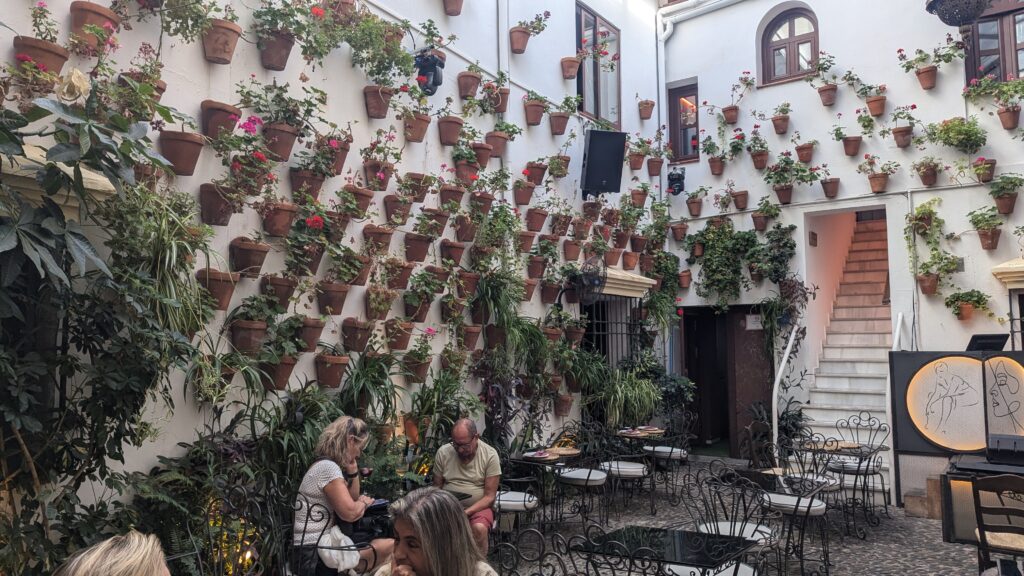
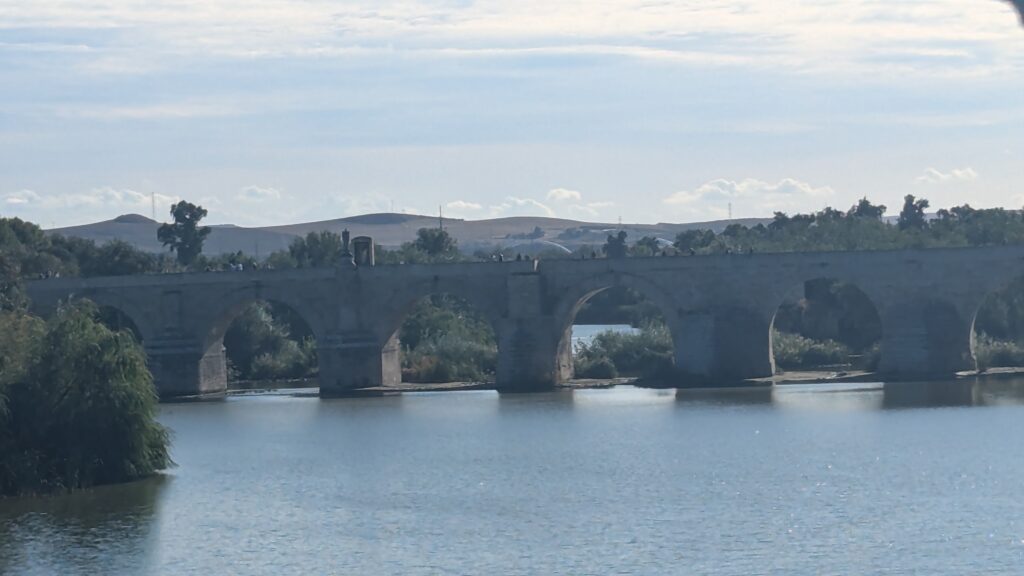
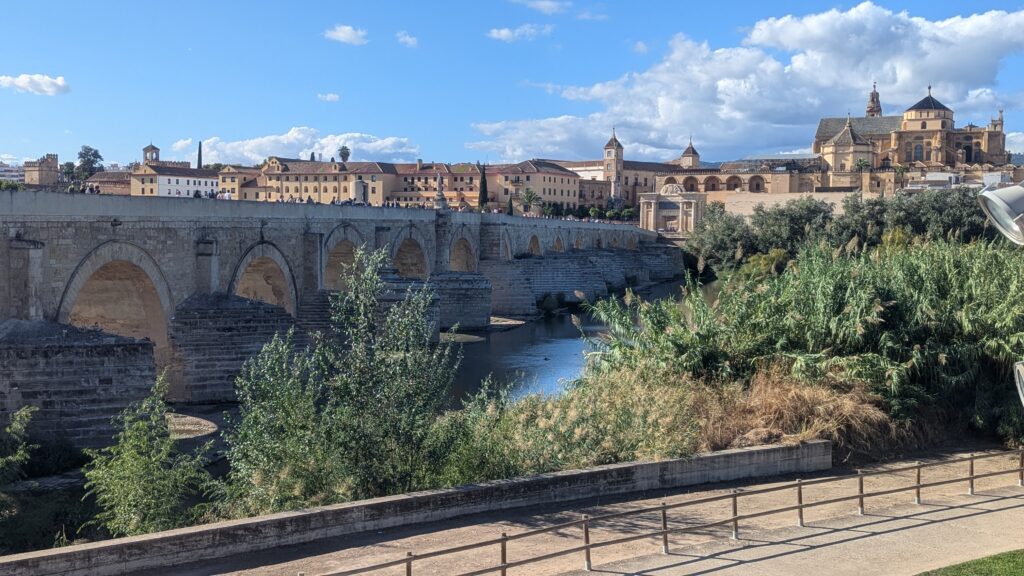
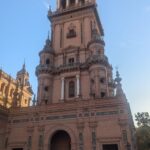
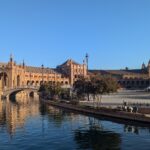
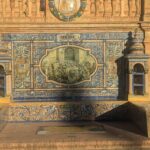


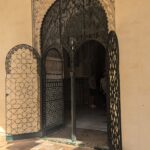
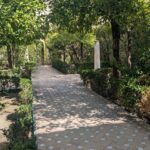
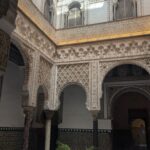
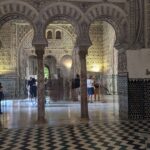
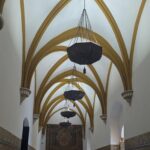
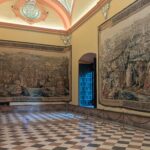
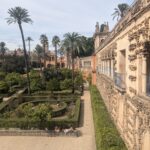
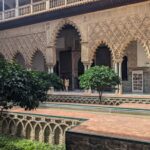
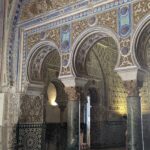

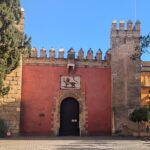
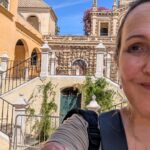
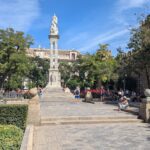
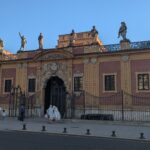
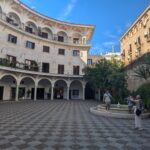

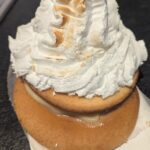

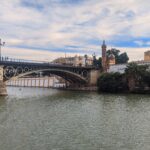
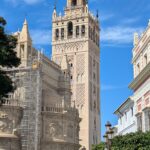
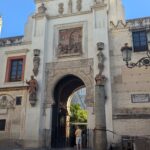
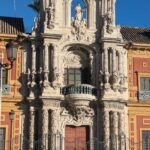
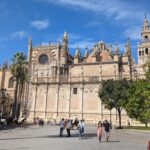

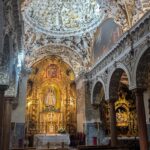

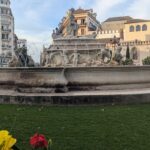
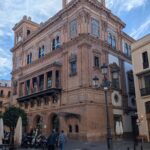
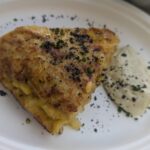


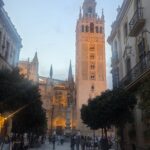


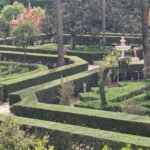
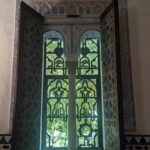
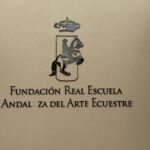
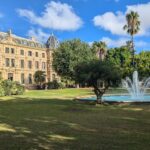

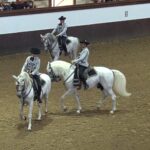
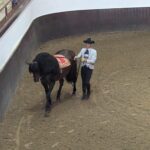
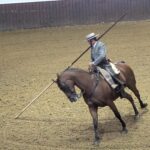
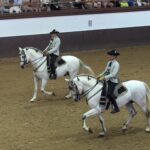
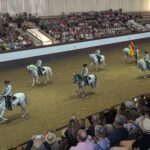
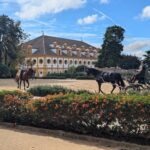
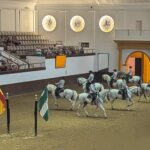
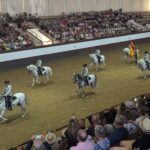
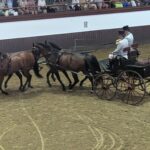
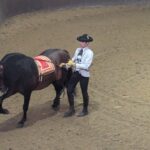
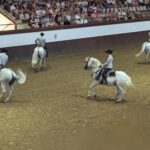
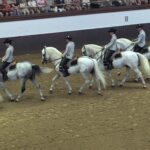
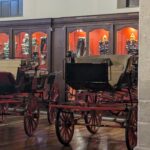
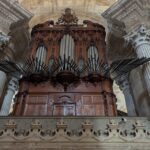
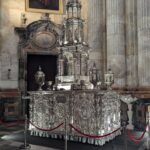
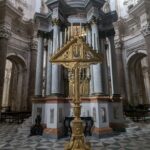
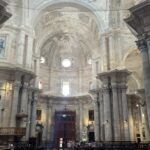
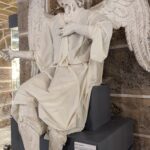
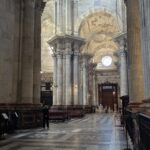
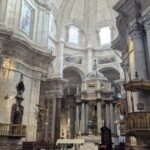
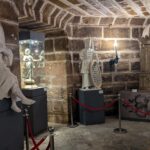
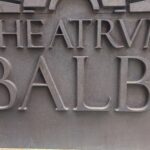
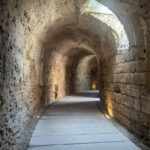
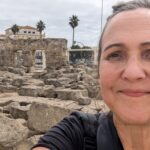
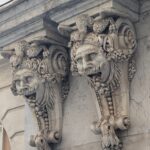
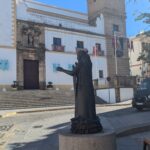

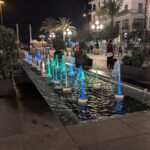


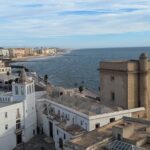

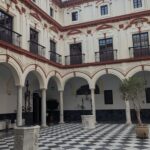
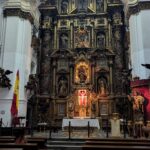
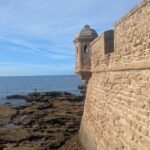
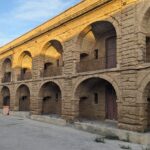
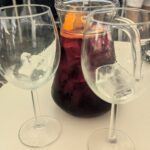
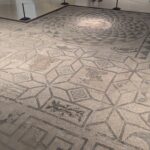
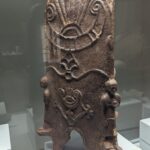
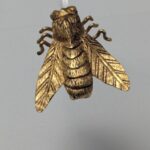
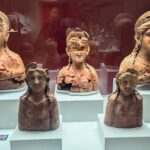
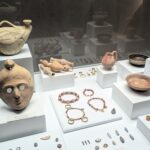

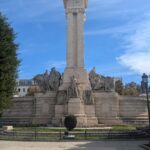
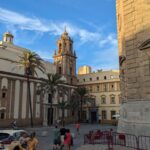
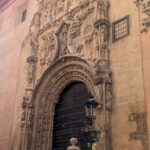

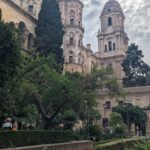
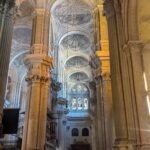
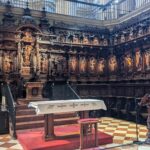

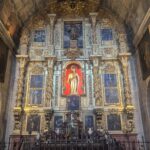
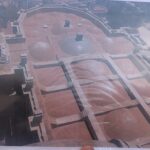
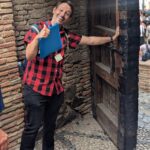

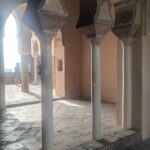
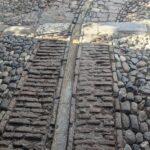
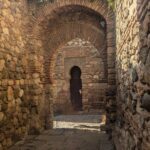

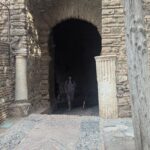

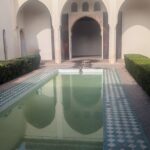
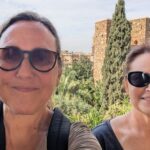
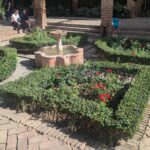
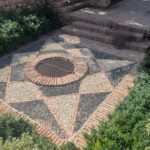
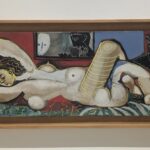
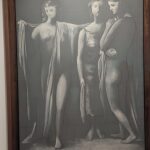
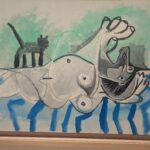
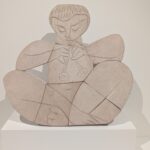

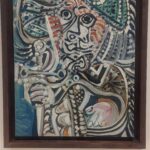
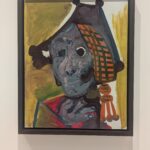
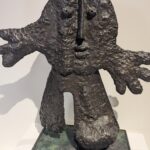

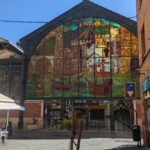
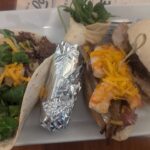
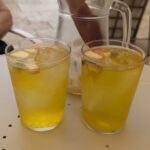
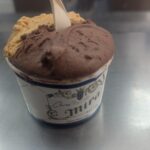
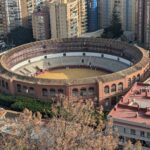
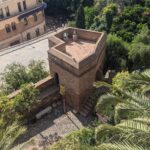
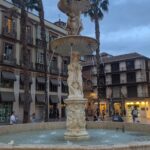
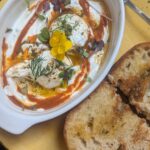
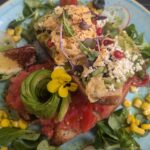
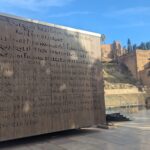
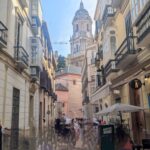
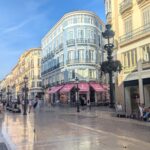
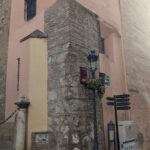

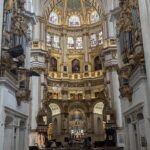
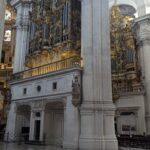
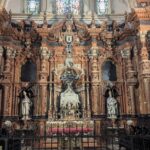

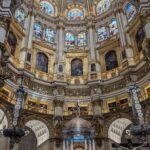

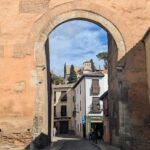
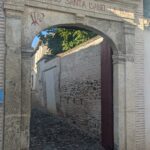


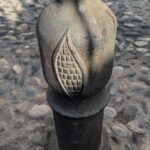




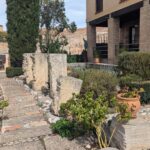
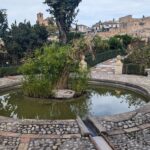
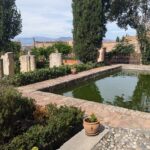

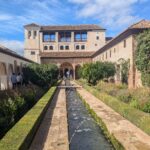

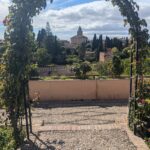

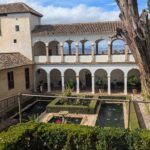

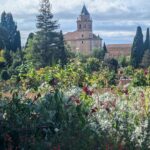

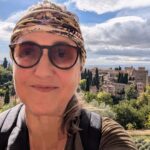
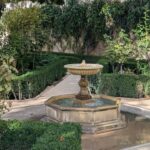
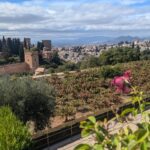
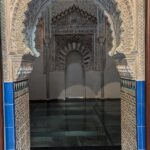
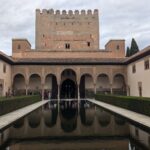
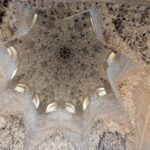

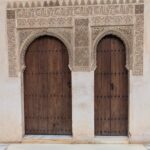
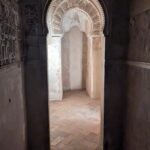
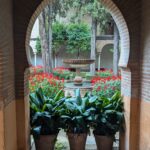
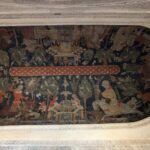

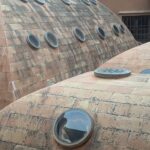
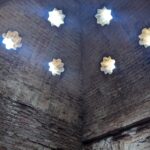




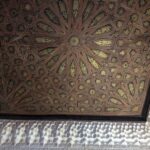
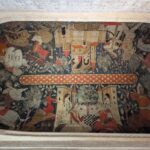
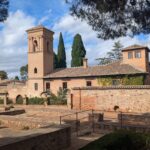
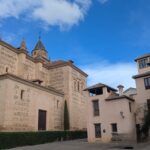

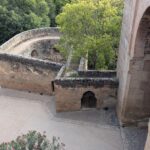
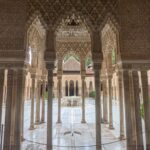
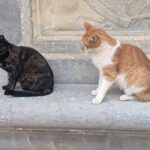

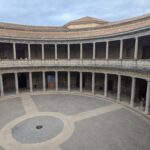
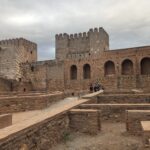
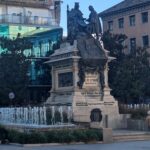
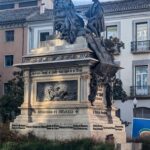
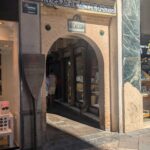
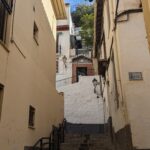
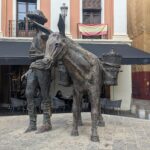

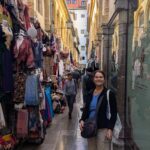
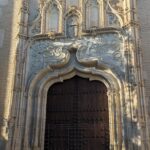
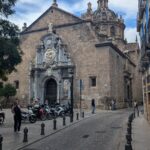
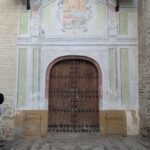
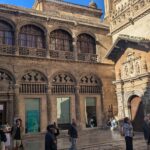
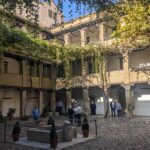
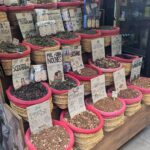
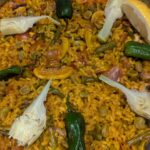
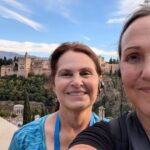
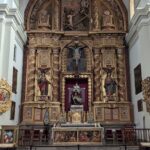

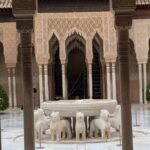
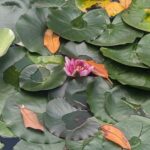

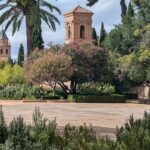

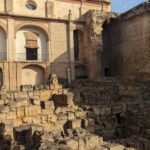
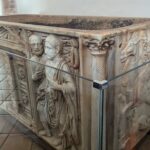

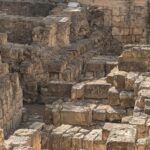
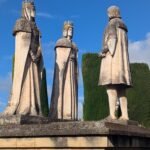
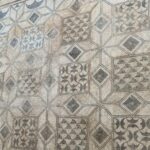
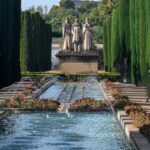

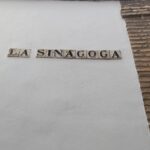
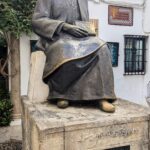

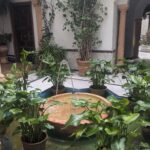
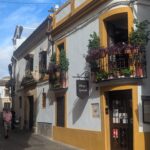
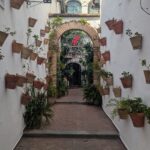
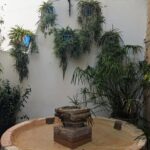
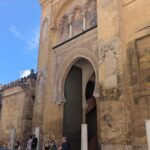
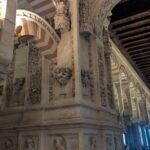
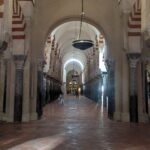
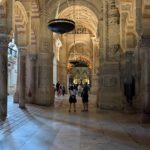
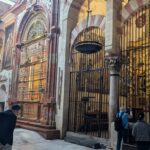
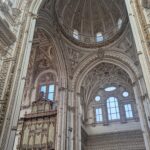
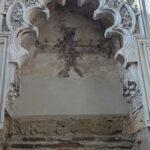
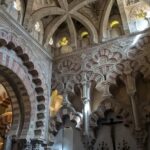
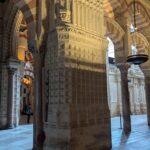

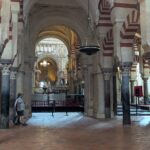
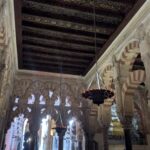
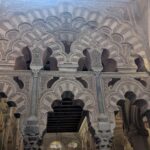
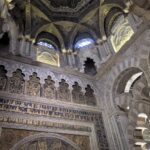
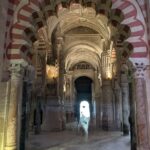

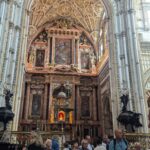
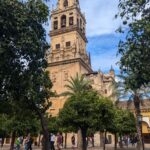
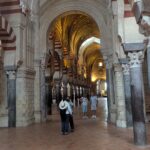
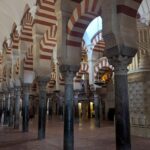
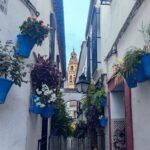

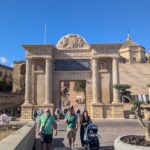
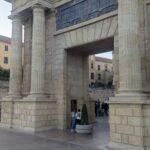

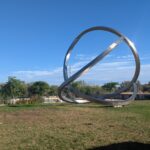
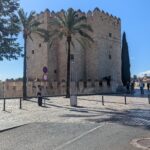
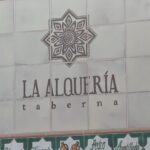

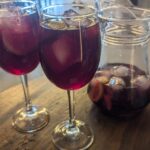
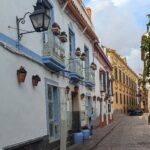

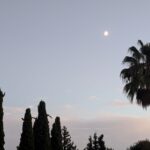
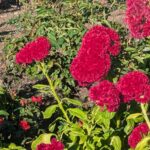
2 thoughts on “Andalusia: Seville, Cadiz, Malaga, Granada, Cordoba”
Good day! I know this is kinda off topic but I was wondering which blog platform are you using for this website? I’m getting fed up with WordPress because I’ve had issues with hackers and I’m looking at options for another platform.
I would be grateful if you could point me in the direction of a good platform.
WordPress and bluehost.